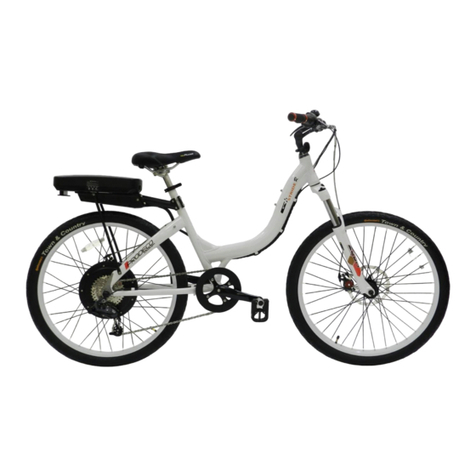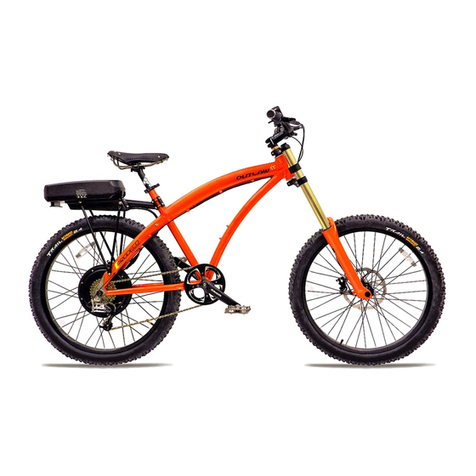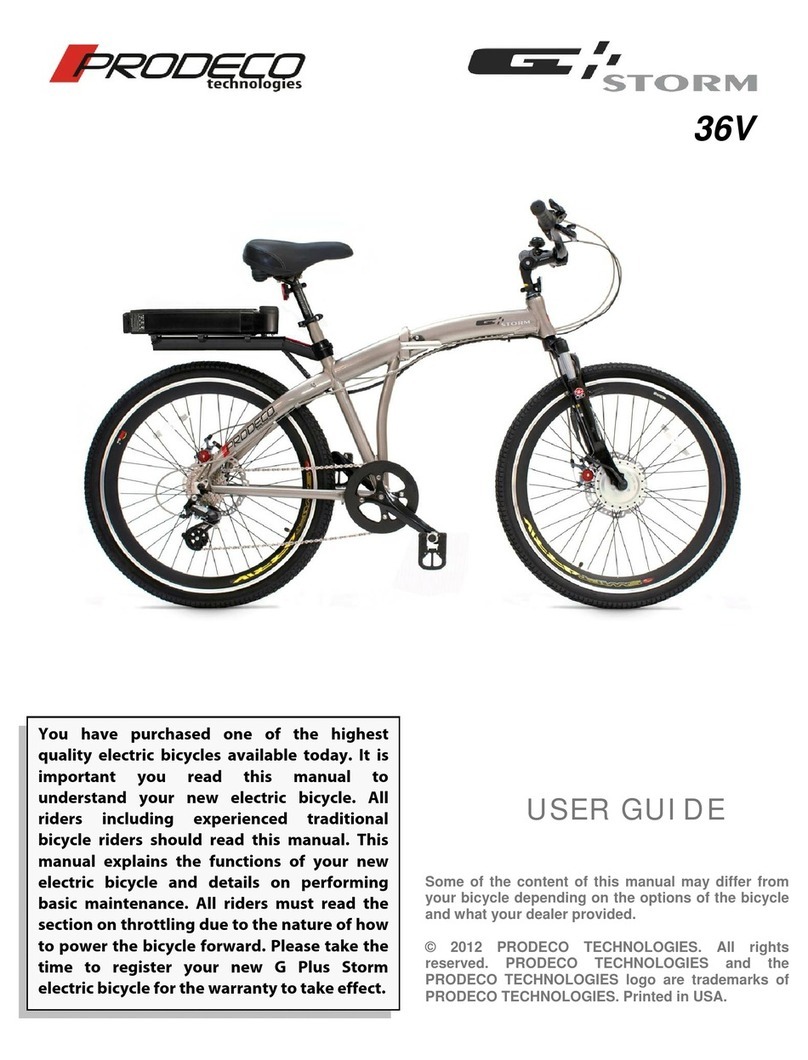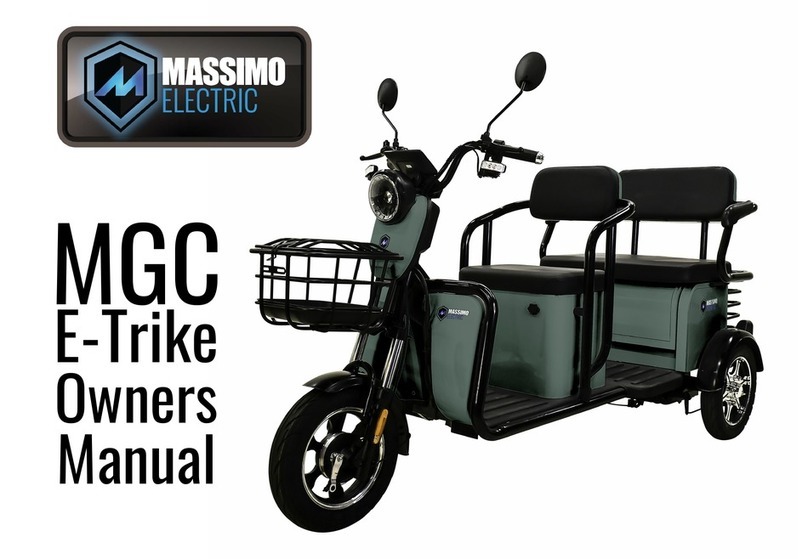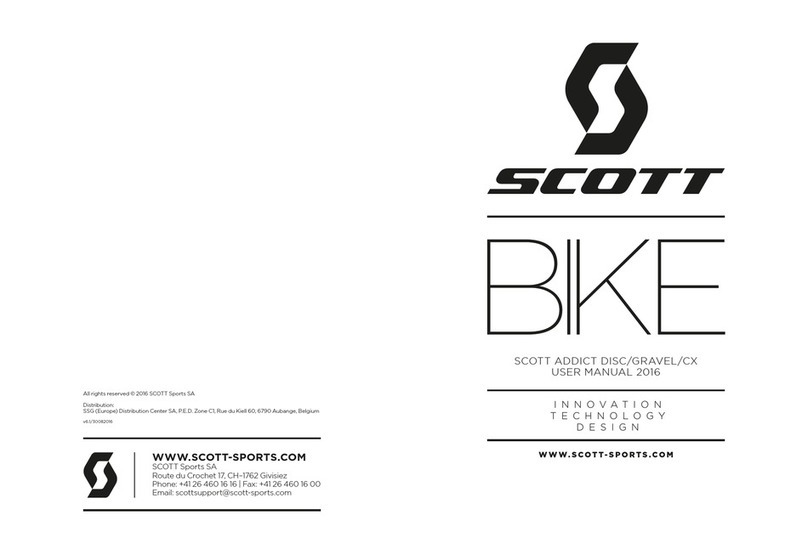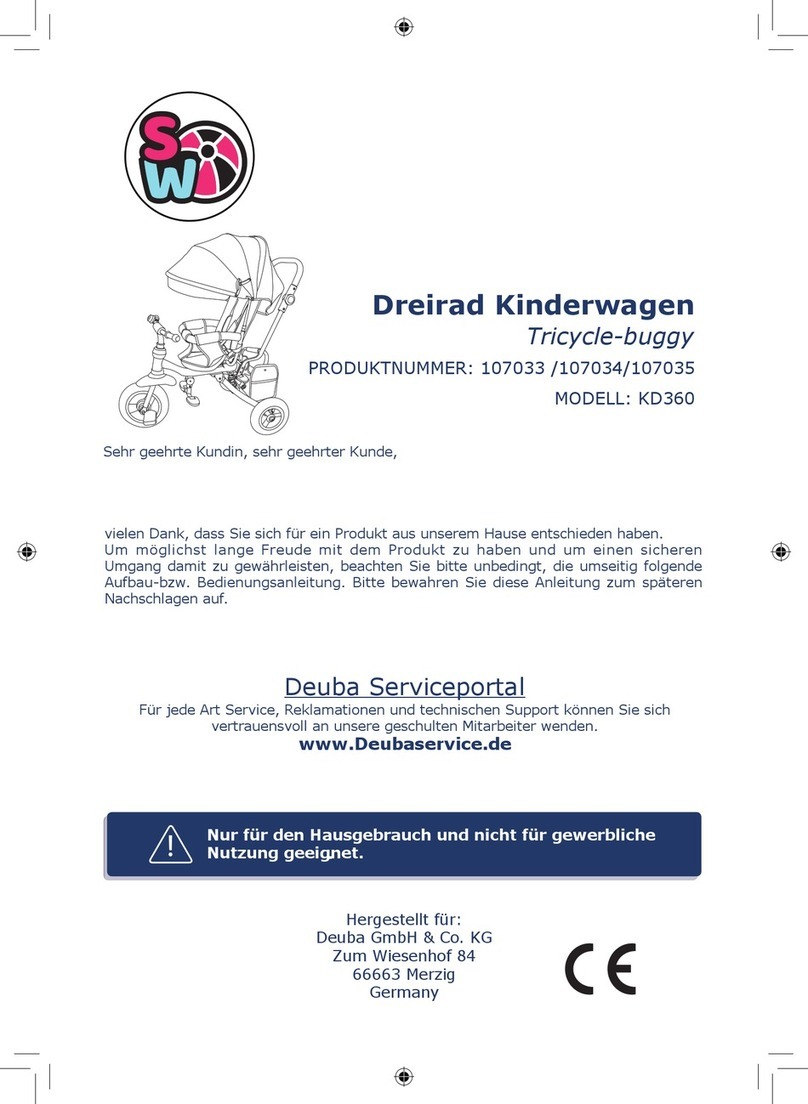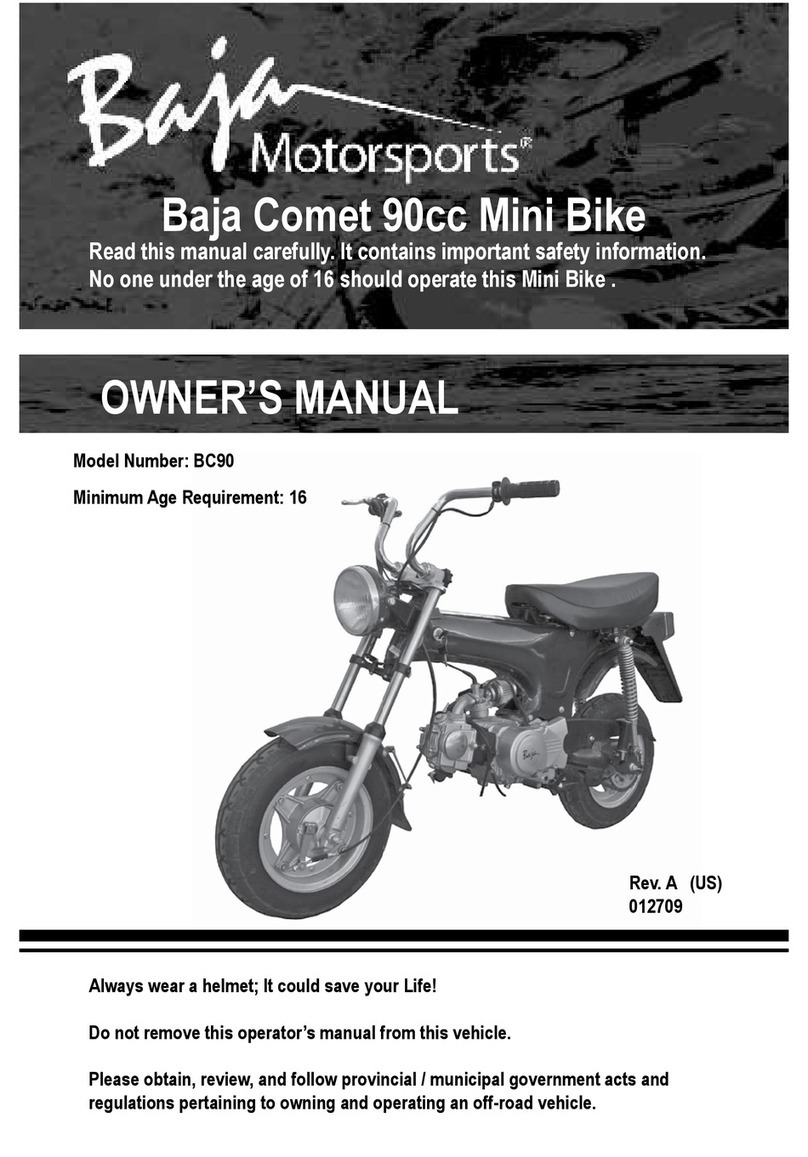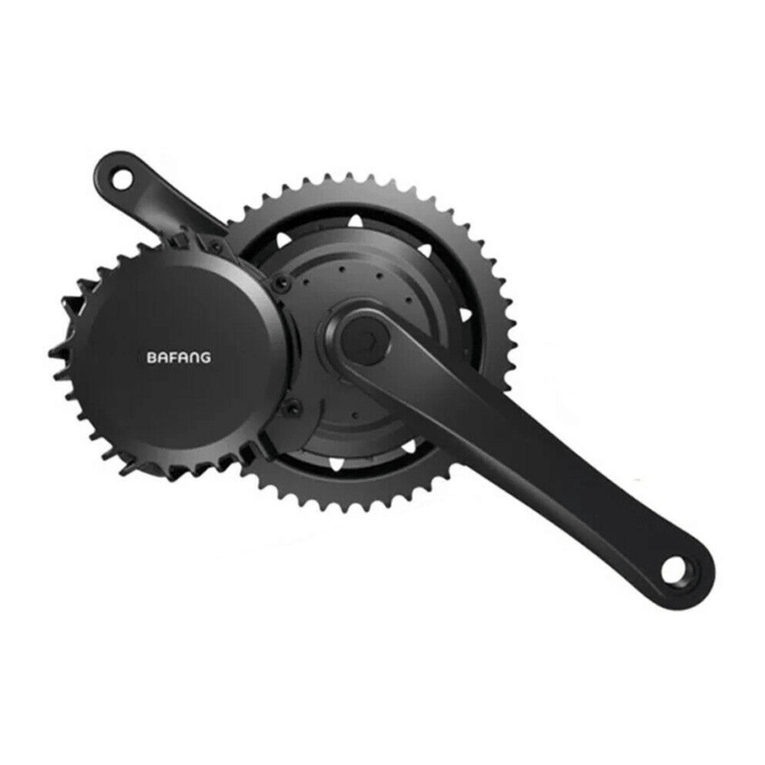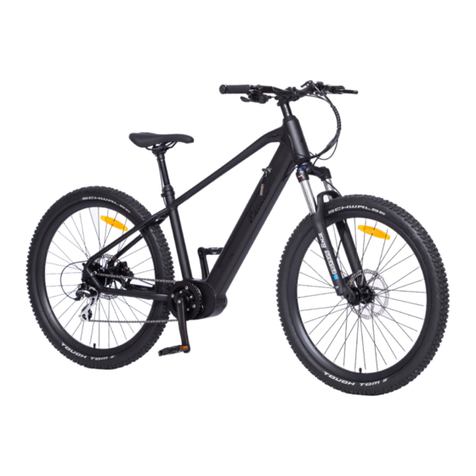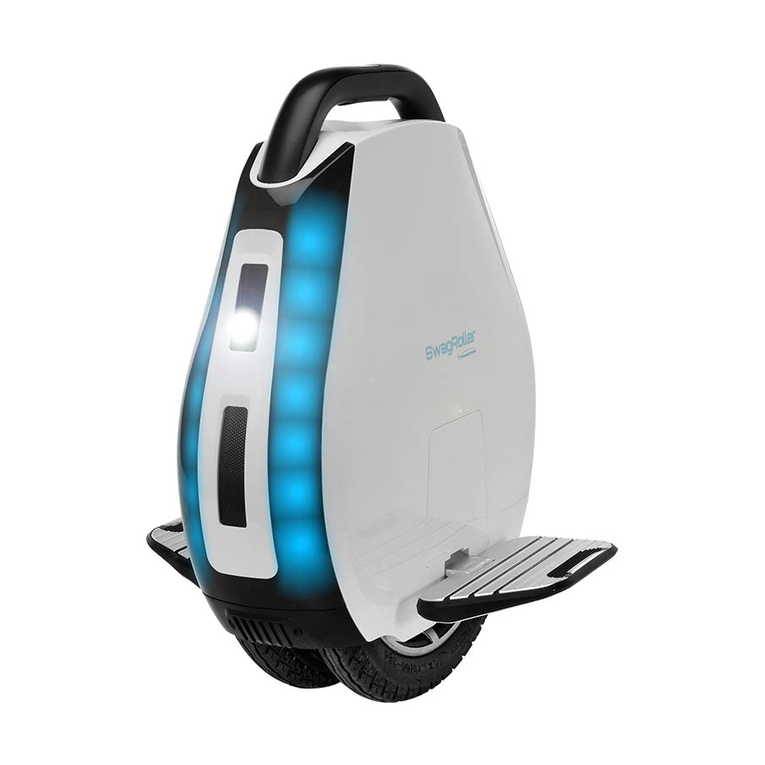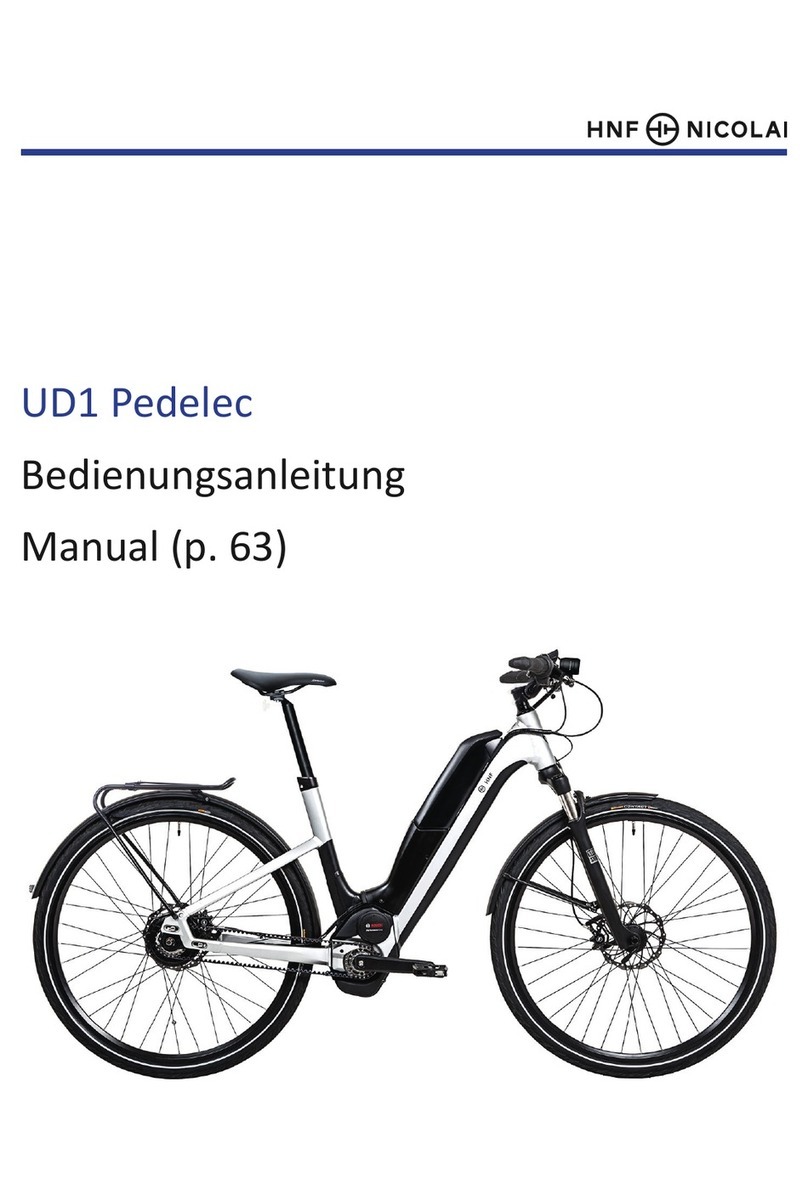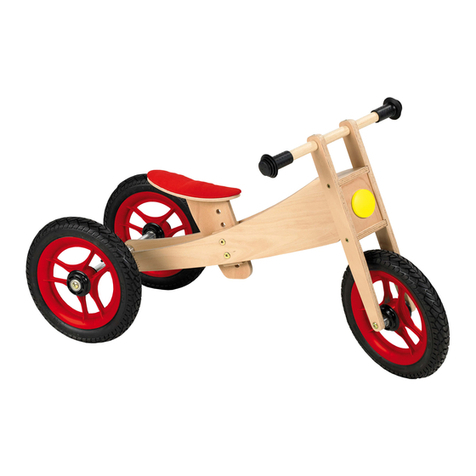Prodeco Technologies Phantom X2 2013 User manual

Some of the content of this manual may differ from
your bicycle depending on the options of the bicycle
and what your dealer provided.
© 2013 PRODECO TECHNOLOGIES. All rights
reserved. PRODECO TECHNOLOGIES and the
PRODECO TECHNOLOGIES logo are trademarks of
PRODECO TECHNOLOGIES. Printed in USA.
USER GUIDE
2
2
20
0
01
1
13
3
3
IMPORTANT: ALUMINUM FRAME. NOT INTENDED
FOR HARD RIDING. DO NOT JUMP OR HIT
CURBS, AVOID IMPACTS. INSPECT FRAME FOR
FRACTURES. SERIOUS BODILY HARM CAN
OCCUR IF MISUSED.
SEE MANUAL FOR ADDITIONAL INFORMATION.

2
Table of Contents
1) Chapter 1: Introduction ……………………………………………………………………………………………….. 4
a. About this manual ………………………………………………………………………………………………….. 4
b. Important notices ……………………………………………………………………………………………………4
c. General warning …………………………………………………………………………………………………….4
d. A special note to parents ………………………………………………………………………………………….. 5
2) Chapter 2: Getting Started …………………………………………………………………………………………… 5
a. Unpacking your box ……………………………………………………………………………………………….. 5
b. Folding and unfolding ……………………………………………………………………………………………… 5
c. Familiarize yourself with your bicycle’s parts …………………………………………………………………… 6
d. Contents of the box ………………………………………………………………………………………………... 6
e. A guideline of your Phantom X2 tool set ………………………………………………………………………... 6
f. Registering your new bike ………………………………………………………………………………………… 6
3) Chapter 3: Basic Instructions ……………………………………………………………………………………….. 7
a. Bicycle fit ……………………………………………………………………………………………………………. 7
b. Adjusting the saddle …….…………………………………………………………………………………………. 7
c. Installing and adjusting the handlebar stem ………………………………………………………….…………. 8
d. Your local electric bicycle and bicycle laws …………………………………………………………………..….8
e. Safety first …………………………………………………..………………………………………………………. 9
f. Mechanical safety check ………………………………………………….………………………………………. 10
g. Before your first motorized ride ……………………………………………..……………………………………. 10
h. First motorized ride ……………..…………………………………………………………………………………. 10
i. Riding an electric bicycle …………………………………………….……………………………………………. 10
j. Using your throttle …….…………………………………………………………………………………………….11
k. Using your brakes …………….…………………………………………………………………………………….11
l. Pedaling ……………………….……………………………………………………………………………………. 11
m. Shifting gears ………………………………………………………………………………………………………. 11
n. Watching for obstacles around you ……………………………………………………………………………….12
o. Safe riding in various conditions ……………………………………………………………………………….….12
p. Charging your battery ……………………………………..………………………………………………………. 12
4) Chapter 4: Safety ………………………………………………………………………………………………………. 12
a. The basics ………………………………………..………………………………………………………………….12
b. Riding safety ………………………..……………………………………………………………………………….13
c. Wet weather riding ………………………………………………………………………………………………….13
d. Reflectors ……………………...……………………………………………………………………………………. 14
e. Night riding …………….…………………………………………………………………………………………….14
f. Adding accessories ……..…………………………………………………………………………………………. 14
5) Chapter 5: Perfect Fit and Ride ……………………………..………………………………………………………. 14
a. The basics …………………...……..………………………………………………………………………………. 14
b. Frame size ………………………..……………………………………………………………………………...….14
c. Recommended sizing ……………..………………………………………………………………………………. 14
d. Control position adjustments ………………………..……………………………………………………………. 14
e. Brake lever height adjustments ………………………..…………………………………………………………. 15
f. Suspension fork adjustment ………………………..……………………….……………………………………. 15
6) Chapter 6: Tire, Tube, Wheel or Axle Repair ……………………………………………………………………… 15
a. Removing the rear motor wheel ………………………..………………………..………………………………. 15
b. Installing the rear motor wheel ………………………..……………………………………………………….….16
c. Removing and installing the front wheel ……………………..………………………………..……………..…. 16
d. Replacing a tube or tire …………...………………………………………………………………………………. 16
7) Chapter 7: Maintenance and Replacement ………...………………………………………………………………18
a. Keeping your bike clean ………………..………………..………………………..……………………………….18
b. Avoid scratching your bike …………………..…………..………………………..……………………………….18
c. Brake bed-in and adjustments ………………………………………..…………..……………………………….18
d. Brake pad replacement ………………………………….………………………..………………………………. 19
e. Derailleur adjustments ………………………..…………………………….……..………………………………. 20
f. Wheel check ………………………………..……………..………………………..……………………………….21
g. Lubricating ………………………..…………………………….…………………..………………………………. 21
h. Crankset …………………………………….……………..………………………..……………………………….22
i. Pedals ……………………………………………………..………………………..………………………………. 22
j. Headset …………………………………..………………..………………………..……………………………….22
k. Maintenance schedule …………………………….……..………………………..……………………………….22
l. Torque specifications for common parts ……………....………………………..………………………………. 23

3
8) Chapter 8: Battery Management ……………………………………………………………………………………..23
a. About your battery ………………………………………..………………………..………………………………. 23
b. Removing the battery …………………..………………..………………………..………………………………. 23
c. Installing and locking the battery ……………………....………………………..………………………………. 24
d. Charging the battery ………………………..……………………………………..………………………………. 25
e. Storing the battery ………………………………………..………………………..………………………………. 25
f. Battery power indicator ………………………..………………………..………………………………………….25
g. Battery replacement ……………….……………………..………………………..……………………………….25
h. Battery disposal …………………………………………..………………………..………………………………. 25
9) Chapter 9: Electrical Components ………………………..………………………………………………………… 26
a. HUB motor ………………………………………….……..………………………..……………………………….26
b. Brushless hall sensor controller ……………….………..………………………..……………………………….26
c. Wiring harness ……………………………………………………………………..………………………………. 26
d. Throttle ………………………..………………………..………………………………………………………...….26
10) Chapter 10: Warranty Service and Repair ………………………………………………………………………….27
a. 2 year limited warranty …………………………………..………………………..………………………………. 27
b. Registering your bike ……..…………………….………..………………………..……………………………….28
c. Serial numbers and where to find them ………………..………………………..………………………………. 28
d. Registration card …………………..……………………..………………………..………………………………. 28
e. Part replacement procedure …………...………………..………………………..……………………………….29
f. Contacting Prodeco Technologies ……………………..…………….…………..……………………………….29
11) Chapter 11: Specifications …………………….………………………………...……………………………………29
12) Chapter 12: Parts ……………………………………………………..…….…………………………….…………… 30

4
OPERATIONAL INSTRUCTIONS
Chapter 1: Introduction
Prodeco Technologies thanks you for your purchase of your new Phantom X2. Your bicycle is a high quality and
environmentally friendly light electric vehicle. This manual will serve to provide you with the information needed to
operate, maintain and enjoy it safely. Your electric bicycle should provide you with years of healthy enjoyment provided
you follow these steps.
For technical questions or customer service, please contact PRODECO TECHNOLOGIES at 800.943.6190 or e-mail us
at service@prodecotech.com.
a) About this manual
To prevent serious injury to yourself and others, and to prevent damage to the bicycle please read and understand these
instructions completely before operating your Prodeco Technologies Phantom X2. Your new bicycle is a powerful and
reliable electric bicycle. You should use caution and care while getting accustomed to your bicycle’s riding
characteristics. The following manual will provide basic instructions regarding your bicycle’s care and maintenance,
battery management, operating procedures, and other important information. You should read it thoroughly before riding
your new bicycle for the first time. If you have any questions that are not answered in this manual, contact your local
authorized Prodeco Technologies dealer or you can call customer service at 800.943.6190.
b) Important notices
Always remove the key from the battery when your bicycle is not in use, replacing a component or performing
maintenance.
Make sure your electric bicycle is properlyfitted to you as described in Chapter 3 ―Basic Instructions‖.
Perform the mechanical safety check described in Chapter 3 ―Basic Instructions‖ section f ―Mechanical safety check‖
beforeeachride.
You should ride your Phantom X2 as a traditional bicycle under pedal power prior to riding under motor power for the first
time.This will allowforthe familiarization of howyour Phantom X2 rides andbalances.
When riding under power for the first time, press the variable throttle very slowly only after pedaling to a slow speed to
understand the strength of the front motor’s performanceandgriponthe roadsurface.
Always applyfullfront& rear brake lever pressurewhenattempting to mount or dismount the bicycle.
Whenattemptingtomountordismountthe bicycle, thekeyshould beintheoff positiononthe battery.
Please read the battery pack and detailed charging instructions found in Chapter 8 ―Battery Management‖ before
charging the batterypackforthe firsttime.
Youshouldfullycharge the Li-ionLiFEPO4batteryaccordingtothe charging instructionsbeforeyour firstride.
You should always fully charge your Li-ion LiFEPO4 battery every 10 miles regardless of the amount of small trip
distances.
Youshouldalways fullycharge your Li-ionLiFEPO4batterypack aftereachroundtripride exceeding 7.5 miles.
Always storethebatterypackinacool anddryplace.
During periods of prolonged storage, the batterypack should be charged at least once every 6 months at a minimum of
60%orevery3 monthsat40%.Donot chargehigher than60% when storing.
Your Phantom X2 can be ridden as a traditional bicycle; it is strongly recommended that you also assist with pedaling
whenriding whichcangreatlyincreasethe distancebetweenbatterycharges.
When ridingunder power, you canenhancedistance inbetween charges byholding the throttle at 10%belowfull throttle.
When riding under power, add as much non-powered coasting (similar to traditional pedaling) byreleasing the throttle and
allowingthebicycletofreelycoastunderitsownmomentum.Thiswillgreatlyincreasethe distancebetweencharges.
Familiarize yourself with throttling (10% below full), pedaling and momentum coasting to optimize the distance being
available per charge. If planning a long trip, applying a combination of the 3 distance enhancing methods mentioned
abovewillallowforanuninterruptedpowersupplyfortheentireride.
c) General warning
Like any sport, bicycling involves the risk of injury and damage. By choosing to ride a bicycle, you assume the
responsibility for that risk, so you need to know —and to practice —the rules of safe and responsible riding and of
proper use and maintenance. Proper use and maintenance of your bicycle reduces risk of injury.
This Manual contains many ―Warnings‖ and ―Cautions‖ concerning the consequences of failure to maintain or inspect
your bicycle and of failure to followsafe cycling practices.
WARNING: This image followed by the word WARNING indicates a potentially hazardous situation that,
if not avoided, could result in serious injury or death.
CAUTION: This image followed by the word CAUTION indicates a potentially hazardous situation, which,
if not avoided, may result in minor or moderate injury, serious, damage to the bicycle or the voiding of your
warranty or is an alert against unsafe practices.

5
Many of the Warnings and Cautions say, ―you may lose control and fall‖. Because any fall can result in serious injury or
even death, we do not always repeat the warning of possible injury or death. Because it is impossible to anticipate every
situation or condition that can occur while riding, this Manual makes no representation about the safe use of the bicycle
under all conditions. There are risks associated with the use of any bicycle which cannot be predicted or avoided, and
which are the sole responsibility of the rider.
d) A special note to parents
The ProdecoTechnologies Phantom X2 is intendedfor use byadult riders only. Manystate laws require electric bicycle riders
to be aminimum age of 16 with some states having minimum ages set as low as 10 years old and other states up to 18 years
old (at the time of the writing of this manual). As a parent or guardian, you are responsible for the activities and safety of your
minor child including the following of your state and local laws in regards to the riding of an electric bicycle by a minor (under
the age of 18).That includes,if your state allows a minor toride, making sure that your minor child cansafely ride and control
allof the operations of thebicycle, andfullyunderstands all warnings andcautions as indicatedinthis User Guide. Pleaseread
on if you have determined that your minor child can legally and safely ride and control all of the operations of the bicycle. That
includes making surethat the bicycle is properly fitted to the child; that itis in goodrepair and safe operatingcondition; that you
and your child have learned and understand the safe operation of the bicycle; and that you and your child have learned,
understand and obeynot only the applicable local motor vehicle, bicycle and traffic laws, but also the common sense rules of
safe andresponsible bicycling. As a parent or guardian, you should read and understandthis manual. Before letting any child
ride the Phantom X2 or anyof ProdecoTechnologies electric bicycles, review with them all warnings and cautions; as well as
the information on the proper usage of your battery pack, charger and bicycle. You must first confirm the laws, rules and
regulations regardingelectric bicycles in your state,cityandlocalmunicipality.
WARNING: Make sure that your child always wears an approved bicycle helmet when riding; but also
make sure that your child understands that a bicycle helmet is for bicycling only, and must be removed when not
riding. A helmet must not be worn while playing, in play areas, on playground equipment, while climbing trees, or
at any time while not riding a bicycle. Failure to follow this warning could result in serious injury or death.
Chapter 2: Getting Started
CAUTION: If you have purchased your bicycle by mail order or through a sales channel whereas your new
Phantom X2 is still inthebox, it is recommended you read Chapter 3 “Basic Instructions” section g “Before your first
ride” priortoyourfirst ride. There may be additional adjustments required due to shippingbythefreight carrier.
a) Unpacking your box
Your Phantom X2 arrives fully assembled in it’s box and only requires the insertion of the seatpost and handlebar stem.
You can learn how to insert the seatpost and adjust for your height in Chapter 3 ―Basic Instructions‖ section b ―Adjusting
the saddle‖. The insertion of the stem and tightening of the stem bolt is detailed on Chapter 3 ―Basic Instructions’ section
c ―Installing and adjusting the stem‖.
The Phantom X2 has been fully tested and adjusted prior to being packed in the Heavy Dutydouble wall box with a form
fitting interior support system. To remove the Phantom X2 from it’s box, open the top flap of the box and remove the top
protection insert. Place one hand under the front portion of the frame and the other hand under the center of the frame.
Pull up slowly and the bicycle will lift out of the box. Remove the additional inserts (if attached to bicycle) and set the
bicycle down by balancing the bicycle on the opened kick stand and both wheels. The kick stand also performs as a
crankset protector. To unfold the bicycle, read the following paragraph, section b.
b) Folding and unfolding (SEE PHOTOS BELOW AND NEXT PAGE)
Folding: Your bicycle has the ability to fold for easy storing and transporting. There is a quick release lever that will
allow the bicycle to fold into half of its original size. The pedals can also be folded by squeezing the 2 metal tabs on the
outside edges of each pedal, pulling the pedal outwards and then pushing the pedal down. To fold the bicycle you
should stand on the right side of the bicycle (the crank set and chain side) and then unclasp the frame hinge lever after
turning the small safety release latch up. You will now be able to fold the bicycle in half. To pick up the bicycle once it
has been folded, you place one hand under the front portion of the frame and one hand under the center of the frame in
front of the seat tube. If folding the bicycle for storage in a closet or small space, after folding, you can roll the bicycle on
its own wheel using the saddle nose and handlebar to guide it to the storage area.
Unfolding: Your bicycle can easily be unfolded in a matter of seconds. Stand on the right side of the bicycle (the crank
set and chain side) and place one hand around the front portion of the frame and one hand under the center portion of
the frame behind the frame hinge. Open the frame to a straight position until the spring in the hinge clasp lever locks
the lever in place. Close the lever completely and turn the hinge safety release latch down (clockwise) to lock the frame
hinge lever in place. For some, it may be easier to use the handlebar stem and seat post to unfold or fold the bicycle.
Confirm the seat post and handlebar stem are tight and secured.

6
c) Familiarize yourself with your bicycle’s parts
d) Contents of the box
Check the contents of your box. Your new Phantom X2 should include the following items in the box or your dealer
should have included these items with your purchase:
Phantom X2 electric bicycle
Velo Plush saddle
Prodeco Tech 36V 12Ah LiFEPO4 battery
36V LiFEPO4 charger
Charger power cable
2 keys
Multi-use nickel plated tool set
3 Arm Y tool (4, 5 & 6mm)
2 cable ties (for future use)
e) A guideline of your Phantom X2 tool set
The Phantom X2 includes a multi-use tool set. This tool set includes all the tools necessary to make adjustments and
service your new bicycle. The only additional tool you will ever need is an 18mm wrench to remove the front wheel. All
other tools are included with the tool kit. The toolkit includes the following tools:
Philips Screwdriver
Flat Head Screwdriver
2mm Hex Key
2.5mm Hex Key
3mm Hex Key
4mm Hex Key (multi & Y)
5mm Hex Key (multi & Y)
6mm Hex Key (multi & Y)
8mm Hex Key
Torx 25
Chain Pin Removal
Spoke Nipple Wrenches
f) Registering your new bike
For the warranty to take effect, you must register your new bicycle. Registration of your electric bicycle is the onlyway we
can acknowledge and verify the established owner. Your bicycle has 3 individual and unique serial numbers (frame,
motor and battery). Each serial number must be registered when filling out the registration form. The serial number on
the frame is located under the crank/bottom bracket portion of the frame. The serial number for the motor is found on the
motor’s side. The serial number for the battery is located on the barcode label adhered to the underside of the battery.
These numbers should be recorded and registered in case of warranty issues or theft. Please review Chapter 10
―Warranty Service and Repair‖ section c ―Registering your bicycle‖ how to register your Phantom X2. You can register by
either filling out the online registration form at www.prodecotech.com/register-your-bike/ or by sending the registration
card found in Chapter 10 ―Warranty Service and Repair‖ section d ―Registration card‖.

7
Chapter 3: Basic Instructions
a) Bicycle fit
It is very important your Phantom X2 is properly adjusted for comfort and to avoid the possibility of losing control while riding.
The saddle and handlebar have adjustments available to allow riders from 5’ 6‖ to 6’ 6‖ to set the proper measurements
allowing for a safe and comfortable riding position. There are saddle height, rotation and distance tosteering tube adjustments
and also ahandlebarheight and rotation adjustment. If you plan to use your electric bicycle also as a traditional pedal bicycle, it
is recommended you adjust the saddle height to allowfor a fullleg extension when pedaling. The ball of your foot when resting
on the pedal should only allow for a slight bend at the knee when seated. Please review the following points in determining
how tomakethe correctadjustments.The subsequent sections willassist you with making theseadjustments.
1) Isyourbikeadjustedtoyoursize?
2) Tocheck,seeChapter5―Perfect Fit and Ride‖.Ifyourbicycleisnotproperlyadjustedforyou,youmaylosecontrolandfall.
3) Isthesaddleattherightheight?Tocheck,seeChapter5―Perfect Fit and Ride‖ sectiona―Stand over height‖.
4) Are saddle and seat post securely clamped? A correctlytightened saddle will allow no saddle movement in any direction.
SeeChapter3―Basic Instructions‖ sectionb―Adjusting the saddle‖ fordetails.
5) Are the stem and handlebars at the right height for you? To check, see Chapter 5 ―Perfect and Ride‖ section c ―Handlebar
height and angle‖.Ifnot,seeChapter3―Basic Instructions‖ sectionc―Installingandadjustingthehandlebarstem‖.
6) Can you comfortablyoperate the brakes? If not, you have the abilityto adjust their angle and reach. See Chapter 5 ―Perfect
Fit and Ride‖ sectione―Brake lever height adjustments‖ for details.
7) Do you fully understand how to operate your new bicycle? If not, before your first ride, have your dealer or contact us to
explainanyfunctionsorfeaturesthatyoudonotunderstandafterfullyreadingthismanual.
b) Adjusting the saddle
You have the ability to adjust the height of your saddle instantly via the quick
release clamp. There is also the ability to tilt the nose of the saddle up or down
and adjust your riding position to be further or closer to the handlebar. The latter
two require the use of the multi-use tool included with the purchase of your
Phantom X2. Please review the following details on adjusting your saddle.
To adjust the height of the saddle or remove the seat post, no tools are required.
The quick release lever is opened by pulling the lever away from the seat tube
allowing for the seat tube clamp to loosen the grip around the post. This will allow
you to raise or lower the saddle to the desired height. There is a minimum
insertion line on the seat post which must be followed and you must not extend
the seat post past this mark. It is also important the seat tube clamp is tightened
sufficiently around the seat post for it not to slide downwards after the quick
release lever is closed. This can be accomplished by tightening the quick release
nut clock wise which is located on the oppositeend of the quick release lever.
WARNING: The seat post includes a minimum insertion mark. It is important you do not allow the seat
post to be clamped below this mark. This mark must be inserted into the frame pass the top of quick release
clamp. If clamping below this mark, it can cause the seat post to break, failure to follow this warning could
result in serious injury or death.
CAUTION: The seat tube quick release clamp must be checked for tightness to ensure the saddle will not
accidentally slide into the seat tube when riding. This can cause a rider to lose balance and may result in a fall.
To tilt the nose of your saddle upwards or downwards, you will need to use the 5mm hex key included with your multi-use
tool kit that came with your bicycle. The saddle mounting clamp attaches the saddle to the seat post via a front and rear
barrel nut and bolt. To bring the nose of the saddle down, loosen the rear bolt by 1 full counter clockwise rotation and tighten
the front bolt by 1 full clockwise rotation. Check for comfort and if the nose is still too high, attempt the above step again.
Continue to adjust by repeating the step above until the desired nose height is established. If you prefer to raise the nose,
you canfollow the abovestep but in the oppositedirection (loosen the front bolt counter clockwise 1 rotation and tightenthe
rear bolt clockwise 1 rotation). All bolts should be tightened to 140 in*lb. (SEE PHOTOS NEXT PAGE)
CAUTION: The saddle mounting clamp front and rear barrel nut and bolt must remain tight at all times.
Test saddle for looseness or play in the rotation of the nose. If saddle is loose, tighten the clamp bolts to ensure
the saddle will not accidentally rotate up or down when riding. Both bolts should be tightened to 60 in*lb. If
loose, this can cause a rider to lose balance and may result in a fall.
Your saddle can be adjusted to be closer or further away from the steering tube/handlebar (you will need to use the 5mm
hex key included with your multi-use tool kit). This adjustment is minimal but allows a 7.5mm adjustment in either direction
from center mount (15mm total, close to 5/8‖). To adjust the saddle closer or further, you must loosen the rear and front
barrel nut and bolt set which connects the saddle rails to the saddle mounting clamp located at the top of the seat post.
Loosen both bolts by rotating 2 times counter clockwise each. This should allow for sufficient looseness to slide the saddle
rails in either direction on the saddle mounting clamp. You must not allow the edge of the saddle mounting clamp to meet
with the saddle rail bends. The edge of the clamp must be a minimum of 5mm from the saddle rail bends. Upon establishing
the correct position, tighten the saddle mounting clamp bolts 2 times in clockwise direction. Check for tightness of bolts and
continue turning if loose. All bolts should be tightened to 140 in*lb. (SEE PHOTOS NEXT PAGE)
CAUTION: The saddle mounting clamp front and rear barrel nut and bolt must remain tight at all times.
Test saddle for looseness or play in the rotation of the nose. If saddle is loose, tighten the bracket bolts to
ensure the saddle will not accidentally rotate up or down when riding. Both bolts should be tightened to 140
in*lb. If loose, this can cause a rider to lose balance and may result in a fall.
CAUTION: The edge of the saddle mounting clamp must have a minimum of 5mm of clearance from the
saddle rail bends. If the edge of the clamp is mounted to close the saddle rail bends and the rider does not
position themselves properly on the saddle, this could result in the rails becoming unstable due to the leverage
of the riders weight. The rails can bend and can cause a rider to lose balance and may result in a fall.

8
c) Installing and adjusting the handlebar stem (SEE PHOTOSNEXTPAGE)
When the handlebar and stem of the Phantom X2 is shipped, it is not inserted into the steerer tube. The handlebar and stem is
temporarily attached to the frame with shipping ties. Using scissors, cut the ties to free the handlebar and stem from the frame.
You willneedtoslide the stem’s quill into the steerer tube and set the stem to the preferred height forriding. The steerer tube is at
the inside and center of the headset. The stem quill must be inserted to the minimum insertion mark located on the side of the
quill. Before inserting the quill, confirm the forks are facing forward and the brake, shift and throttle cables are not twisted. To
confirmtheforks arefacingforward,thefrontdiscbrakerotorshouldbefacingthe leftsidewhen sitting onthe bike,thesameside
as the rear rotor. To confirm the cables are not twisted, you may need to spin the handlebar. The cables should not be wrapped
aroundthestemorhandlebarandfreeofanytype ofpossiblerestriction.
Onceinsertedto the desiredheight, removethesmallplasticstemquillboltcoverandusingthe6mmhexkeyof the Ytool, slightly
tightenthestemquillboltbutnotfully. Youwillneedtoalignthehandlebar andstem withthefrontwheelprior tofullytightening.To
align the handlebar and stem, stand in front of the bicycle and hold the front wheel between both knees as not to allow the wheel
tomove. Usingthe grips of the handlebar, alignthe stem straight with the front wheel. The handlebar itself should cross the wheel
from left to right ina perfect straight line and intersectthe stem at a 90º angle. Once the handlebar andstem arealigned, you can
nowfullytightenthestem quillbolt.YouwillneedtotightenatfullforceifusingtheYtool.Atorquewrenchshouldbeusedandthe
stem quill bolt should be tightened to 20.8lb*ft. After tightening the stem quill bolt, reinsert the stem quill bolt cover. It is very
importantthestemboltisproperlytightenedasnottocomelooseduringaride.
The stem can also be adjusted for rise.When adjusting for rise, the stem will rotate closer to the rider allowing for a moreupright
position. The rotation adjustment bolt is torqued and tightened at the factoryprior to shipping. If adjusting the rise of the stem, you
mustproperlytighten the rotation adjustment bolt afterwards. A loose rotation bolt can becomeverydangerous during aride if the
stem drops from not being properly tightened. To adjust theriseofthe stem,locate the adjusting bolt on the right side of the stem.
Using the 6mm hex keywhich is included with the multi use tool kit which came with your bicycle, loosen the rotation adjustment
bolt. Pivot the stem to the desired riding position and tighten the rotation adjustment bolt. You will need to tighten at full force if
usingthemultiusetoolkit.Atorquewrenchissuggestedandtherotationadjustmentboltshouldbetightenedto180lb*in.
WARNING: The handlebar controls will be rotated upwards upon adjusting stem higher. Loosen the 4 stem
binderboltsandrotatethehandlebardownwardstoapreferredridingposition.Tightenstem binder boltsto90lbs*in.
CAUTION: The handlebar stem quill bolt and rotation adjustment bolt must be checked for tightness to ensure
thehandlebarstemwillnotaccidentallyslideinto thesteering tubeorthehandlebardoes notturnthe wheelorthestem
risefallsuponriding. Failureto tighten can causearidertolosebalance and mayresult inafall.
d) Your local electric bicycle and bicycle laws
Your new Phantom X2 was designed to follow the federal guidelines to establish the Phantom X2 as a traditional pedal power
bicyclewithinmostUSAstatesandtobeallowedtorideinbicyclepathways.However,electricbicyclelawschangeoftenandyou
are responsible to confirm legalstatus of the riding of your electric bicycle in bicycle pathways. Below is a referencesectionon the
USAelectricbicyclefederalguidelines:
Electric Bicycle Laws (please contact your local transportation department for the specific laws in your state and city regarding
ridingelectricbicyclesonbikepathways)
Prodeco Technologies offers the following information as guidance and does not guarantee or assure riders they are
followingtherulesandregulationsoftheirstate.
Electric bicycle laws may vary by state to state with most states following the classification of that by the CPSC (Consumer Product
Safety Commission), DOT & NHSTA. Further, the US NHSTA (National Highway Traffic Safety Administration) defines low-speed

9
electric bicycles(under 20mph)also as consumerproductsand notMotor Vehiclesforsafetystandards.TheNHSTAadheresfor the
mostparttotheCPSCguidelines.WeincludedreferencebelowonhowelectricbicyclesareperceivedbytheFederalGovernment’s
mostimportantagencies.Wedobelievenewregulationandruleswillapplyinthefutureupontheelectricbicyclebecomingoneofthe
standard forms of transportation for the masses. Prodeco Technologies will continue to follow new rules and guidance set forth by
theseagencies,alwayswelcomingandadheringtotheguidelinestheyfeelarerequiredtoassuresafetyfortheelectricbicyclerider.
On October 22, 2008, the Federal Highway Administration (FHWA) updated the Bicycle and Pedestrian Provisions of
FederalTransportationLegislationto maketechnicalcorrectionsandclarifications.
Belowaretheimportant updates reflecting electric bicycles:
Motorized Vehicle Use: In general, motorized vehicles are not permitted on non-motorized trails and pedestrian walkways funded
under Title 23. Exceptions to this general rule exist for maintenance vehicles; motorized wheelchairs; when State or local
regulations permit, snowmobiles; and electric bicycles (weighing under 100 pounds and a top speed of less than 20 miles per
hour); "and such other circumstances as the Secretary deems appropriate" (except the Recreational Trails Program which
specifically provides funds for motorized trails). In 2008, FHWA developed a Framework for Considering Motorized Use on Non-
motorizedTrailsandPedestrianWalkwaystoimplementthe"othercircumstances"provision.
Prodeco Technologies only offers electric bicycles that fall under the category of ―weighing under 100 pounds and a top speed of
less than 20 miles per hour‖. According to the DOT and NHSTA, Prodeco electric bicycles meet the exception of Motorized
Vehiclesandthereforecanberiddenonnon-motorizedtrails andbikepathspermittingstateandlocallaws.
FrameworkforConsideringMotorizedUseonNon-motorizedTrailsandPedestrianWalkwaysunder23 U.S.C.§217
The purpose of this document is toprovide guidance to Federal HighwayAdministration (FHWA) division offices and a consistent
frameworkfordeterminingwhen topermitanexceptionformotorizeduseonnon-motorizedtrailsand pedestrianwalkwaysunder
23U.S.C. §217(h)(5).Therelevantlegislation readsas follows:
23 U.S.C. § 217. Bicycle Transportation and Pedestrian Walkways (h) Use of Motorized Vehicles.--Motorized vehicles may
not be permitted on trails and pedestrian walkways under this section, except for-- (1) maintenance purposes; (2) when snow
conditions and State or local regulations permit, snowmobiles; (3) motorized wheelchairs; (4) when State or local regulations
permit,electricbicycles;and(5)suchothercircumstancesastheSecretarydeemsappropriate.
(j)Definitions.--Inthissection,thefollowingdefinitionsapply:
(2)Electric bicycle.--The term "electric bicycle" means any bicycle or tricycle with a low-powered electric motor
weighing under100pounds,witha top motor-poweredspeednot inexcessof20milesperhour.
(4) Wheelchair.--The term "wheelchair" means a mobility aid, usable indoors, and designed for and used by individuals with
mobilityimpairments,whether operatedmanuallyor motorized.
The above23U.S.C.§217offers directionthattheProdecoElectricBicyclesareallowedonbike-paths(non-motorizedtrails)due
toProdecoelectric bicyclesfallingunder theclassificationoflessthan 100pounds andunder20mph.
HR727
SECTION 1, CONSUMER PRODUCT SAFETY ACT
TheConsumerProductSafetyAct(15U.S.C.2051etseq)isamendedbyaddedattheendofthefollowing:
LOW-SPEEDELECTRICBICYCLES
SEC. 38.(a) Notwithstanding anyother provision of law, low-speed electric bicycles are consumer products within the meaning of
section3(a)(1)andshallbesubjecttotheCommissionregulationspublishedatsection1500.18
(a)(12)andpart1512of title16,CodeofFederalRegulations.
(b) For the purpose of this section, the term `low-speed electric bicycle' means a two or three-wheeled vehicle with fully operable
pedals and an electric motor of less than 750 watts (1 h.p.), whose maximum speed on a paved level surface, when powered
solelybysuchamotorwhileriddenbyanoperatorwhoweighs170pounds,islessthan20mph.
(c) To further protect the safety of consumers who ride low-speed electric bicycles, the Commission may promulgate new or
amendedrequirementsapplicabletosuchvehiclesasnecessaryandappropriate.
(d) This section shall supersede any State law or requirement with respect to low speed electric bicycles to the extent that such
Statelaworrequirementismorestringent thantheFederallaworrequirementsreferredtoinsubsection (a).
SEC.2.MOTORVEHICLESAFETYSTANDARDS.
For purposes of motor vehicle safety standards issued and enforced pursuant to chapter 301 of title 49, United States Code, a
low-speed electric bicycle (as defined in section 38(b) of the Consumer Product Safety Act) shall not be considered a motor
vehicleasdefinedbysection30102(6)of title49,United StatesCode.
Local BicycleLaws
Most states have their own set of bicycle laws regarding traditional pedal powered bicycles. With moststates recognizing electric
bicyclesastraditionalpedalpoweredbicyclesyoumustlearnthe applicablelaws in yourarea. YourDepartmentofTransportation
orCycleClubsinyourareawillhavethedetails involving riding a bicycle in your area and your city’s bike pathways. Requirements
for riding will change depending on location. Most cities requiring LED lights, hand signals, riding on the correct side of the road,
ridingbehindandnotparalleltoother cyclist, etc…
e) Safety first
It is important you follow your local bicycle laws but also it is important you ride safely. Below are examples of understanding
how to ride your new Phantom X2 safely. Always wear an approved helmet when riding your bike, and follow the helmet
manufacturer’s instructions for fit, use and care of your helmet.
Do you have all the other required and recommended safety equipment for your area? It’s your responsibility to
familiarize yourself withthelaws of theareaswhereyou ride,andto complywith all applicablelaws.
Do you know how to correctly check your wheel axle nuts? Do you understand proper braking techniques? Is your
saddle properly adjusted? Howdo you power your new electric bicycle? These are all questions you should have the
answers toprior toriding for the first time.This USER GUIDE will answermostof the questions youhaveinregardsto
your new bicycle and assist you in ensuring your electric bicycle remains safe to ride. You shouldfirst read the USER
GUIDEinits entirety andfamiliarize yourself with your new bicycle prior toriding.
Forfurther safetyguidelines,pleaseread Chapter4:Safety

10
f) Mechanical safety check
Check the condition of your bicycle before everyride.
Nuts, bolts and straps: Make sure nothing is loose. Lift the front wheel off the ground by two or three
inches then let it bounce on the ground. Anything sound, feel or look loose? Do a quick visual and tactile
inspection of the whole bike. Are there any loose parts or accessories? If so, secure them. If you’re not
sure, ask someone with bike experience to check.
Tires and Wheels: Make sure tires are correctly inflated, see Chapter 6. Check by putting one hand on the
saddle, and the other on the intersection of the handlebars and stem, then bounce your weight on the bike
while looking at tire deflection. Compare what you see with how it looks when you know the tires are
correctly inflated; and adjust if necessary. Are the tires in good shape? Spin each wheel slowly and look for
cuts in the tread and sidewall. Replace damaged tires before riding the bike. Spin each wheel and check for
brake clearance and side-to-side wobble. If a wheel wobbles side to side even slightly, or rubs against or
hits the brake pads, take the bike to a qualified bike shop to have the wheel trued.
Brakes: Check the brakes forproper operation. Squeeze thebrake levers. Are the brakes properlyreleasing?
All control cables seated and securely engaged? Do the disc brake pads grasp the rotors within an inch of
brake lever movement? Can you apply full braking force at the levers without having them touch the
handlebar? If not, your brakes need adjustment. Do not ride the bike until the brakes are properlyadjusted.
Quick Releases: Make sure seat post, rear axle & frame quick release levers are properly adjusted and all
are in the locked position.
Handlebar and saddle alignment: Makesurethesaddle and handlebar stem are parallel to the bike’s center line,
clampedandboltstightenedenough so that you can’t twistthem outof alignment.Ifnot,alignandtightenthem.
Handlebar ends: Make sure the left handlebar grip and right throttle grip are secure and in good condition.
If not, replace them.
Battery Pack Attachment: Ensure your battery pack is firmly attached to your bicycle before riding. To test
battery attachment, pull up on the battery pack handle after battery is locked in place. If attached properly
you will not be able to slide the battery off the bike. If not, the battery pack will slide off the bike.
CAUTION: The braking of your bicycle is one of the highest concerns in safety. Proper brake lever
mounting and cable adjustment is crucial for your brakes to work properly.
WARNING: All Quick release levers must be closed and the clamps or axles tight. One loose quick
release lever can cause the rider to lose control and cause serious injury or death.
WARNING: Loose or damaged handlebar grips or extensions can cause you to lose control and fall.
Unplugged handlebars can cut your body, and can cause serious injury in an otherwise minor accident.
g) Before your first motorized ride
Before your first ride study this manual in its entirety. Make sure you are comfortable and confident when sitting on the
bicycle. If an adjustment does not feelright or something feels loose, check to ensure you are properlyfitted to the bikeand
do a mechanical safety check as explained in the previous section. Make sure you fully charge your battery with the
appropriate charger included with your bicycle. Be sure to firmly attach the battery to the bicycle. Try to slide the battery off
the bike bythe battery handle to confirm proper installation. Read Chapter 3, section h. (thefollowing section) again.
h) First motorized ride
When you buckle on your helmet and go for your first familiarization motorized ride on your new bicycle, be sure to pick a
controlled environment, away from cars, other cyclists, obstacles or other hazards. Ride to become familiar with the
brake levers against throttling, variable throttle performance while pedaling your new bike and not pedaling. The first
motorized ride should be initially pedaling and then slowly pressing down on the throttle to feel the engagement of the
HUB motor. Familiarize yourself with the sensation of power.
Familiarize yourself with the braking action of the bike. To test the brakes at slow speed, shift your weight
toward the rear and gently apply the brakes, rear brake first. Sudden or excessive application of the front
brake could pitch you over the handlebars. Applying brakes too hard can lock up a wheel, which could
cause you to lose control andfall (seesection j.).
Your bike has a front suspension system, familiarize yourself with how the suspension responds to braking
application and rider weight shifts.
Check out the handling and response of the bike; and check the comfort.
If you have any questions, or if you feel anything about the bike is not as it should be, take the bike back to
your dealer for advice or contact Customer Service at Prodeco Technologies.
i) Riding an electric bicycle
Riding an electric bike is similar to riding a non-electric bike but there are some differences to note. An electric bike is
slightly heavier and requires more time to stop due to higher traveling speeds. Your bike is also equipped with a powerful
motor that provides a boost noticeable when starting from a stop. The boost is exhilarating, but you must be comfortable
with the sensation before riding in crowded or congested areas. To maximize battery life, assist with pedaling, engage
throttle to 90% or less and add considerable coasting with no throttle to your riding. Your battery is a finite resource and
proper riding techniques will prolong its distance per charge.

11
j) Using your twist throttle
The variable throttle on your Phantom X2 was designed
toallow youthe abilitytochoosethe speed to ride at and
determine the amount of torque off the line. The throttle
operates similar to an automobile; the twisting of the
throttle mimics the depressing of the accelerator. The
throttle is located on the right side grip and considered a
half twist throttle. It is a half twist, as only the inside
portion will twist to power the bicycle. The grip itself will
nottwist.Usingyouforefingerandthumb, youcan safely
twist the throttle to propel the bike forward. A half twist
throttle is used to avoid accidentally twisting the full grip
when mounting and dismounting the bicycle. Your
throttle also includes a Power ON and Power OFF
button. It is the red button located underneath the LED
lights. Depressing the button in activates the throttle and
pressing the button out will deactivate the throttle. The
ON/OFF button isforfurthersafety. Thereisalsoan
LED set of lights which assist in determining the amount of battery storage capacityremaining. This is discussed infurther detail
later in themanual.Throttlingisan important factorwith any electric bicycleand thedistanceof traveling available percharge.The
higher the speed, the less distance per charge, the faster you accelerate off the line, the less distance per charge. If there are
multiple stops and take offs, this also affects the range of distance per charge. It is recommended you become accustomed to
your style of riding and adjust the style depending on distance needed per charge. For example: if you are planning a short local
trip, full throttle at takeoff and top speed will not be an issue due to your abilityto be able to recharge the battery prior to the next
trip. If you are planning a longer trip,10-15 miles ormore, it is suggested you add pedaling, holdthrottle back 10% and whenever
possible allow the bicycle to coast under no power. Coasting under no power is similar to riding a traditional pedal powered
bicycle. When riding, a rider will pedal for a few seconds and then stop pedaling, allowing the bike to coast with no power being
used. Thiswillgreatlyincreaseyourdistancebetweencharging.(SEEPHOTO)
k) Using your brakes
Your Phantom X2 is equipped with a high performance ―Tool Free‖ adjusting Avid BB7 Disc Brake system. The BB7 front
and rear disc brakes allow your new Phantom X2 to stop quickly and accurately. Oversized Avid HS ―Heat Shedding‖
stainless steel disc rotors were utilized for the axles for increased heat dissipation. When properly adjusted, the Phantom
X2 high performance disc brake system offers tremendous stopping power. Prior to leaving the factory, the Phantom X2
brakes were adjusted tight and properly tested. Due to cable stretching from new condition, your brakes may need to be
readjusted within a few weeks of riding. Please refer to Chapter 7 ―Maintenance and Replacement‖, section c ―Brake
adjustments‖ to adjust your brakes for optimum performance. When braking, both brake levers should be applied
simultaneously. Your left brake lever manages your front brake and your right brake lever manages your rear brake. You
should first become accustomed with the stopping power of each brake (front & rear). Test each brake separately in a
controlled environment for their ability to stop the bicycle. Front brakes when locked can cause the rear wheel to come off
the ground and the rider can be thrown off the bicycle. In emergency situations, apply pressure to each brake lever, shift
your weight to the back of the bicycle and only attempt to use full force on the front brakes when the bicycle is not stopping
quicklyenough.Always keepa safe distance between vehicles, pedestrians and other bicycle riders from yourself.
WARNING: Locking the front wheel during braking can cause the rear wheel to lift off the ground and
throw the rider off the bicycle. Both brake levers should be applied simultaneously. In an emergency situation
shift your weight to the back of the bicycle. Locking the front wheel can cause the rider to lose control, be
thrown off the bicycle and cause serious injury or death.
l) Pedaling
Pedaling your Phantom X2 is the same as pedaling a traditional bicycle. It is recommended you add pedaling to the
power of the bicycle to enhance the distance per charge. The Phantom X2 is a 8 speed bicycle and has the ratio of a
44T front chain ring (sprocket) against a 11-28T rear freewheel which is designed to offer an easy pedaling pace at any
speed from 1 MPH to 18 MPH. It is recommended on steep inclines, the rider utilizes the throttle to assist in powering the
bicycle up the incline and simultaneously drop the bicycle to a lower gear. If a rider’s style of riding is throttle only with no
pedaling, distance per charge will be decreased on a steep incline, the rider is required to assist the motor by pedaling to
power up the incline.
m) Shifting gears (SEE PHOTO)
The shifting of gears is required to change the ratio of the rotation of pedaling to
allow more or less torque and lower or higher speeds according to one
complete rotation of the crank set. If requiring more torque, you will shift to a
larger rear sprocket for a higher rotation of pedaling to a lower speed of the rear
wheel. To switch to a larger rear sprocket, you will need to shift to a lower gear.
Gear 1 is the largest sprocket which is 28 Teeth and your lowest gear. One full
crank rotation creates a 1.57 turn of the rear wheel. For higher speeds from less
rotation of the crankset on flat pathways, you will shift to a smaller rear sprocket
for a higher wheel rotation to a lower crankset speed. To shift to a smaller
sprocket, you will need to shift to a higher gear. Gear 8 is the smallest sprocket
with 11 Teeth and your highest gear. One full crank rotation creates a 4 turn of
the rear wheel.

12
n) Watching for obstacles around you
Your new Phantom X2 travels at higher speeds than most riders are accustomed to, when compared to pedaling a traditional
bicycle. It is veryimportant you are aware of your surroundings and obstacles which may appear near you. You must watch the
roadsurface you aretraveling onwhichcould cause the tires toslip orcause a flat. Examples are softshoulders,rocks, potholes,
uneven paths, grates, construction sites. Duetothehigher rateof speed whenriding under motor power versus pedaling, objects
willadvanceinto your path at afasterrate.Payattentiontootherridersin yourarea,automobiles,motorcycles,pedestrians,poles,
intersections and road signs to name a few. The Phantom X2 resembles a traditional bicycle and people walking, driving or
standingmaynotrealizeyouareonamotorpoweredvehicleandmisjudgeyourtravelingspeed.
WARNING: Hitting a pot hole, soft shoulder or other road deviation may cause you to lose control, be
thrown and cause serious injury or death.
o) Safe riding in various conditions
Riders may find themselves riding in a condition they did not plan on encountering. It is important your new Phantom X2 is
maintained properlyfor optimum performance. Please read Chapter 7 on the detailsrequired tokeep your electric bicycle at its
best. An unexpected rain storm, snow flurry or night ride could arise during a day’s trip and you should always be prepared.
Pleaseread Chapter 4 on Safety, so upon encountering anunexpectedridingcondition, you will be confident andready.
p) Charging your battery
The Phantom X2’s battery system is the safest and latest technology in Lithium Ion battery cells and was designed to be
easily charged. Chapter 8 offers a detailed explanation on battery management but the following information is a basic
guide in charging your battery. The battery is a removable device and can be charged on or off the bicycle. If removing
the battery to charge it, please follow these instructions.
Locate the key ignition on the battery and turn the key in a counter clockwise rotation to the ―UNLOCK‖
position. You must push the key in to turn from the ―OFF‖ position to the ―UNLOCK‖ position.
Grab the handle at the back of battery and carefully pull towards the back of the bicycle to slide off.
The batteryis now transportable and can be charged awayfrom the bicycle when in ―UNLOCK‖ position.
For charging, please review the following instructions.
Lift up the handle of the battery to access the RCA charging input.
Insert the charging plug from the charger into the battery’s RCA charging input.
Insert the charger’s power cord into a wall outlet.
The charger’s LED light will light RED while the charger is charging the battery.
The charger’s LED light will light GREEN upon the battery being fully charged.
There is also a battery indicator for checking a full charge. Press the indicator button to display the battery’s
energystorage. The indicator is located on top of the battery.
Once the batteryis fullycharged, you should discontinue charging andremove the charger.
Unplug the charger’s power cord from the wall and remove the charging plug from the battery.
You are ready to install the battery pack back onto your bicycle.
To install the battery, first align the bottom of the batterywith the battery base rail.
Once aligned, slide the battery firmly into the battery base and until the battery base terminals insert into the
battery’s terminal outlets. The battery’s locking slots must slide properly onto the mount’s 3 metal tabs.
Once the batteryis properly slid into place, you can then turn the key to the ―ON‖ position.
The LEDs on the throttle in the ―ON‖ position will display a charged battery’s energy capacity.
Chapter 4: Safety
The manual has detailed safety riding methods. In this chapter we will further discuss additional safety guidelines.
a) The basics
Below is a safety guideline according to the CPSC (US Consumer Product SafetyCommission) in regards to riding a bike.
Always wear a helmet to help prevent head injuries.
Observe all traffic laws and signals, just as automobiles must do.
Don’t ride double or attempt stunts.
Ride near thecurb in the samedirection as traffic.
Find alternate routes, rather than ride through busyintersections and heavy or high-speed traffic.
Walk -- don't ride -- your bicycle across busyintersections and left turn corners.
Avoid riding in wet weather. When wet, handbrakes mayrequire a long distance to stop.
Avoid riding in the dark. If you do, be sure the bike is equipped with a headlight, a taillight and reflectors.
Apply retro-reflective trim to clothing, or wear reflective vests and jackets.
Avoid loose clothing or long coats that can catch in pedals or wheels. Leg clips or bands keep pants legs
from tangling in the chain.
Avoid crossingraised sewer grates.
Regular maintenance is essential for safe riding. Refer to the maintenance recommendations. If you do not
have basic mechanical skills, an authorized dealer should perform repairs and maintenance.
Align (or "true") wobbly wheels for better control. Spokes also may need adjustment.
Replace all missing, damaged, or worn parts; for example, brake pads, chainguards, chain links, spokes,
screws and bolts, handlebar grips.
Tighten and/or adjust loose parts.

13
Periodically inspect frame, fork, spindles and other components for cracking.
Parts should be adjusted to manufacturer's torque specifications.
Inflate tires torecommended pressure, and replace worn tires.
Lightly oil andclean moving parts. Keep oil off rubber.
Keep bicycle indoors when not in use.
b) Riding safety
Below are guidelines according to the NHSTA (National Highwayand Traffic SafetyAdministration) on bicycle safety.
Protect Your Head: Wear a Helmet - Never ride a bicycle without wearing a properly fitted helmet. Helmets are
proven to be 85-88 percent effective in preventing traumatic brain injury, the primary cause of death and disabling
injuries resulting from cycling crashes. Wear a helmet that meets the U.S. Consumer Product Safety Commission
(CPSC) standard (seeinside of helmet for presence of a label).
Assure Bicycle Readiness: Ensure Proper Size and Function of Bicycle - Make sure the bicycle fits you: Stand
over the top of the Phantom X2 bicycle –there should be minimum 3 inches of clearance from the frame bar. Seat
height —as previously mentioned, with the ball of your foot on the pedal, the fully extended leg should have a slight
bend. Check all parts of the bicycle to make sure theyare secure and working well: The Handlebar should be firmly in
place and turns easily. The wheels must be straight and secure; the quick release rear axle must besecured.
Stop It: Always Check Brakes Before Riding - Always control your speed by using your brakes. Apply the rear
brakeslightly before the front brake. Always keep your brakes adjusted. If you cannot stop quickly, adjust your brakes.
Review Chapter 7 ―Maintenance and Replacement‖ section c ―Brake adjustments‖ to adjust the brakes. When your
hand brake levers are fully applied, they should not touch the handlebars. Ride slowly in wet weather and apply your
brakes earlier, it takes more distance to stop.
See and Be Seen - Wear clothes that make you more visible. Always wear neon, florescent, or other bright colors
when riding a bicycle.
Avoid Biking at Night - It is far more dangerous to bicycle at night than during the day. The Phantom X2 requires
LED lights for night time riding. If you must ride at night, you should also do the following: wear retro-reflective clothing
or material, not just white or florescent, especially on your ankles, wrists, back, and helmet. Only ride in areas familiar
to you. Brightlylit streets are best. Always assume you are not seen bya driver. Children should NOT ride at night.
Go With the Flow: The Safe Way is the RIGHT Way - Ride on the right side in a straight, predictable path. Always
go single file in the same direction as other vehicles. Riding against traffic puts you where motorists don't expect you.
They maynot see you, and may pull across your path, or turn into you.
Check for Traffic: Always Be Aware of the Traffic Around You - Over 70 percent of car-bicycle crashes occur at
driveways or other intersections. Before you enter any street or intersection, check for traffic. Always look left-right-left,
and walk your bicycle into the street to begin your ride. If you are already in the street, always look behind you for a
break-in traffic, then signal before going left or right. Watch for left or right turning traffic.
Learn Rules of The Road: Obey Traffic Laws - Bicycles are considered vehicles. Bicyclists must obey the same
rules as motorists. Read your State drivers handbook, and learn and follow all the traffic signs, laws, and rules for
operating a vehicle on the road. Always signal your moves. Be courteous to pedestrians and other vehicle operators.
Never wear headphones while riding as they impair your ability to hear traffic. Become familiar with the
accommodations that are available for bicyclists in your area. These include bicycle lanes and routes as well as off-
road paths. Take advantage of these whenever possible.
“Drive” with Care: Share the Road - When you ride, consider yourself the driver of a vehicle and always keep safety
in mind. Choose to ride in the bike lane, if available. If the roadway or bike lane is wide, ride to the right; if the lane is
narrow, you may choose to ride in the middle of the lane. Take extra precautions when riding on a roadway. Bicycles
are smaller than automobiles, and don’t protect the operator like an automobile. You should: Make eye contact, smile,
or wave to communicate with motorists. Courtesy and predictability are a key to safe cycling; be considerate and
aware of motorists and pedestrians. Learn to anticipate their actions. Remember, pedestrians have the right of way;
Ride far enough away from the curb to avoid the unexpected from parked cars (i.e. opening doors or drivers pulling out
without checking); Keep control of your bicycle: look behind you while maintaining your bicycle in a straight path; be
ableto ride with one hand on the handlebars and signal a turn. (Practice these skills in a parking lot); Always look over
your shoulder, and if possible, signal before changing lanes; Make sure that books, clothes, and other items are
securely attached to the bicycle or carried in a backpack; and Use bells, horns, or your voice to alert pedestrians and
bicyclists that you are approaching or passing.
Stay Focused: Stay Alert - Never wear headphones; they hinder your abilityto hear traffic. Always look for obstacles
in your path (potholes, cracks, expansion joints, railroad tracks, wet leaves, drainage grates, or anything that could
make youfall). Before goingaround anyobject,scan ahead and behind you for a gap in traffic, signal your intentions to
move, and then follow through with your intentions. Be aware of the traffic around you. Ride defensively. Use extra
care when riding in wet weather, ice, frost, or snow. Slow your speed and allow extra time and space to stop. Use
extra care when crossing bridges which are extra slippery under wet conditions. Use caution when crossing a railroad
track; cross tracks at a 90-degree angle and proceed slowly.
c) Wet weather riding
Wheneverpossible,youshouldavoidridingyourbicycleintherain.Ridingabicycleintherainislikedrivingacarinthesnow.You
will not be able to stop as fastand must leave a larger distance between you and the obstacles around you. Your brakes will not
workasefficientlywhentheyare wet. Youwillnotbe able to turnas sharp withoutthe dangerof slipping. Youmustalsoride away
from or be cautious around painted lines, pot holes, sewer or drain grates, rail road crossings, bridges, wet leaves and any other
area where a slipperysurfacecan appear with water.Keep aneye out for puddles and turn your lights on if youhave them.If you
live inanenvironment whererainridingis expected, you shouldinstall front and rear fendersif you havenot alreadydone so.Use
acoverfor your bicycle if leavingitoutdoors.Extensiveraincanseepintothecontroller andbatteryandcausewaterdamage.

14
d) Reflectors
The CPSC (US Consumer Product Safety Commission) requires front, rear, wheel and pedal reflectors. Your Phantom X2
includes federal regulated reflectors and they should not be removed. If needing to be replaced, replace them with authorized
Prodecoreflectorsorreflectorsapprovedbythe CPSC.
e) Night riding
Almost anywhere in the worldtoday, bicycle night riding requires frontand rear lights on your bicycle. You must installfront and
rear lights if you plan on riding at night. Check your local laws on what is required for night riding. Always wear retro-reflective
clothing or material, not just white or florescent, especially on your ankles, wrists, back, and helmet. Onlyride in areas familiar
to you. Brightlylit streetsare best. Always assume you are not seenbya driver. Children shouldNOT rideatnight.
f) Adding accessories
When adding accessories to your bicycle you must check to confirm they do not lower the safety value of your bicycle.
ProdecoTechnologies offers authorized accessoriesfor your bicycle which have been approved not to lower the safety value.
Ask your authorized dealer or contact us if you are not sure about adding an accessory to your bicycle and the possibility of
lowering your bicycle’s overall safety.
Chapter 5: Perfect Fit and Ride
It is very important your new Phantom X2 is adjusted properly for your size and for comfort. The Phantom X2 has multiple
adjustments available to offer a comfortable and safe position for riding. A properlysized and adjusted bicycle allows the rider
to remainfullyalert and avoid injury. Review this chapter carefullyand all the adjusting points of your newPhantom X2. If you
have difficulty in obtaining the most comfortable riding position or performing available adjustments, contact your authorized
dealer for advice. You can contact Prodeco Technologies directly by phone or email and we will assist you with the proper
adjustments for your bicycle and your size. Thefollowinglist is the areasof adjustability the Phantom X2offers:
Saddle height
Saddle noseangle
Saddle distancetohandlebar
Handlebar height
Stem riseandrotation
Brakelever angle
Brakelever reach
Fork suspensionfirmness
a) The basics
Understanding the basics of a bicycle frame size will help in determining the correct positions and adjustments for your body
size and comfort. The Phantom X2’s frame was designed to easily accommodate all riders from 5’ 6‖ to 6’ 6‖ utilizing the
available adjustments. The frame size can be considered anywhere from an 18‖ to 23‖ if comparing to traditional
measurements. The most important information to remember when sizing your bicycle is that you are comfortable riding,
especially when pedaling. With throttled electric bicycles some riders may choose not to pedal and the measurement will be
different than for a rider who chooses to pedal and is the same size. Scooters for instance have a much lower saddle height
than bicycles due to scooters not being pedaled. A higher saddle height is only recommended for riders who pedal allowing
them a full extension of their leg per rotationof the crank.
b) Frame size
The Phantom X2 is consideredan 18‖MTBframe. The typical measurement number used todayin choosinga correct frame size
for a rider is the seat tube length. This number usually is between 17‖ to 19‖ for categorizing MTB bicycle measurements. The seat
tube length is measured from the centerline of the crank (bottom bracket) to the top of the seat tube (seat tube clamp). There is
anothermeasurementsometimesforgottenwhichisactuallymoreimportantandthis isthetoptubelength(seattubetothe steering
tube). With the Phantom X2’s stem being availableadjustable,finetuningofthismeasurementiseasilyaccomplished.
The Phantom X2’s framemeasurement follows the principals of an 18‖ MTB frame; however the actual measurementwill differ
from traditional bicycle frames. This is due to the seat tube being longer than a traditional bicycle. The addition of the battery
mount required an extension to the seat tube by 2 inches; therefore the measurement is 20‖. The Phantom X2 further has a
high rake seat tube angle. With the high angle seat tube, as a tall rider raises their saddle to accommodate their longer legs,
thesaddlewill pull back offering a longerdistancetothe steering tube.
c) Recommended sizing
In today’s bicycle industry, the top tube length is actually more important than the seat tube length. With seat posts now
available over 300mm, the seat tube length is no longer the most important number. The distance of the bottom bracket to
the road should also be taken into consideration when sizing a bike. The top tube length is traditionallythe distance from the
center of the seat tube tothe center of the steering tube. For purposes of sizing the Phantom X2, we will name the distance
of thecenter of the saddle to the center of the handlebar the steering length (similar to the top tube length).
You can adjust the steering length of your Phantom X2 by establishing the saddle position and handlebar height combined
with the adjusting of thestem rise via rotation. The saddle position can be adjusted for height and distance from thesteering
tube via the quick release clamp and the saddle clamp. Keep in mind by increasing the height of the saddle, this will also
increase the steering length due to the angle of the seat tube. If you choose to use your bicycle as a scooter style vehicle
only, you should establish saddle height at a lower position to reduce the center of gravity. Saddle height can be reduced to
just above your inseam. Your inseam is the measurement of the inside of your leg.
d) Control position adjustments
The Phantom X2 includes a twist variable throttle with an LED batteryindicator on the right side and an 8 Speed twist shifter on
the left side of the handlebar. There is also a thumb sliding lever bell on the left side of the handlebar, required by law for electric
bikes as a sounding device. The throttle can be adjusted on the handlebar to rotate further up or down using the 3mm hex key
included with your multi-piece tool kit. The shiftercan be adjusted on the handlebar to rotate using the multi-tool included withthe
bicycle. The brake lever assembly and throttle mount together and at a certain point of rotation, one will not rotate further without
the other requiring to be rotated. If the factorysettings on the throttle or shifter are uncomfortable for you or you cannot view the
LED battery, youcan loosenthe throttleclampandmove it into a preferredposition.As statedabove,youmayhavetoloosenthe
brake assemble to move the throttle to your desired position. Please see section e ―Brake lever height adjustments‖ following this
section to loosen and adjust the brake lever assemblyand maintain correct brakelever height adjustments. Toloosen and adjust
the throttle,locate the 3mm hex bolt at the front underside of the LED batteryindicator on the throttle. Use your 3mm hex keyand
insert it into the hex bolt and rotate a minimum of 3 times counter clockwise. The throttle will now be loose enough to move.
Throttleclampboltsshouldbetightened to25lb*in.

15
YourPhantom X2includesathumbleverbellfor youtousetowarnotherpeople around youwhenapproaching.Thethumblever
bell can be moved to a more comfortable position if the factory setting is unsatisfactory (you will need to use the Philips screw
driverincludedwithyourmulti-piecetoolkit).OntheundersideofthebellhandlebarclampthereisasmallPhilipsscrew.Usingthe
Philips screwdriver, turn the screw counter clockwise 4 rotations to loosen the clamp. This will allowthe bell to be moved.Move
thebelltothedesiredposition andusingyourPhilipsscrewdriver,tightentheclampscrewbyturningclockwiseuntiltight.
e) Brake lever adjustments
The preferred level of the brake lever assemblies will varyfrom rider to rider. The brake lever
assemblies can be rotated to a desired riding position. The optimal position can be found by
extending your fingers straight while sitting in the saddle. Your fingers, when extended
straight,shouldrestontopof theleversorslightlyabovethelevers.
The brake lever assemblies have theclampbolt accessible from the top of the bracket. Using
the4mmhexkey, loosenthebrakeleverassemblybyturning thehexboltcounter clockwise
3 full turns. The lever assembly will now be loose and you can rotate it up or down to
establishthe preferredpositiontoapplythebrakes while riding. The brakelever assemblyon
the right side of the handlebar may require the throttle clamp to be loosened to allow the
brake lever assemblyto rotate. The brake lever assemblyand throttle mount together and at
a certain point of rotation,one will not rotatefurtherwithout theother requiring tobe rotated. A
compromisemaybe required when attempting to align the brake levers and establishing the
preferred throttle position. The optimum position to set your brake levers at depends on your
riding position but it should be the extension of your arm. Your brake lever should be located
at the point where your fingers extend straight out from your arms. Upon finding preferred
brake lever height, tighten hex bolt using 4mm key. Brake lever clamp bolts should be
tightened to80 lb*in.
f) Suspension fork adjustment
The Phantom X2 uses a dual pre-load adjustable suspension fork. The fork’s dual
adjustment offers either a softer of firmer ride for smoothing out the bumps in your path.
The pre-load can be adjusted according to your weight and liking. You can easily adjust
the suspension performance byrotating theknobs at the top of each leg at the crown.
Chapter 6: Tire, Tube, Wheel and Axle Repair
The Phantom X2 was designed for ease of servicing. Repairs are no more difficult than on a traditional bicycle. Any
neighborhood bicycle shop should be able to repair a flat, change a tire or replace a wheel. Please review the following
chapter on how to remove and replace thefront and rear wheel of your Phantom X2.
a) Removing the rear motor wheel
The wheel incorporates a motor wire quick disconnect for removing the wheel. To remove the wheel following these
instructions, it will only take a few minutes. Read the instructions fully before first attempting toremove the wheel.
Prior to removing the wheel, shift the bicycle into gear 7 or 8 (the small COG/sprocket on the rear cassette.
It will be easy to remove the wheel if the chain is at the end of the cassette. Make sure to spin the crank
while shifting gears.
Next, turn the battery ignition key to the ―UNLOCK‖ position and remove the battery.
To work on your bicycle, it may be easier to turn the bicycle upside down by placing blankets on the ground
and resting the bicycle on thesaddle and handlebar.
Locate the motor disconnect weather proof plug on the left side of the bike frame 6 inches from the motor
axle and separate the connector.
Locate the cable tie which tiesthe motor wire to the frame. Cut the cable tie with snips.
On each axle nut there is a rubber nut protector, remove these protectors simply by pulling on them. On the
wired side of the axle,slide the rubber protector up the wire onlya few inches.
Using a wrench, turncounter clockwise each axle nut until the axle washers are loose.
Remove the wheel from the frame by pulling on the wheel.
The 8 speed freewheel mounted to the motor can be slid out away from the chain with no issue. The spring of
derailleurmaycausethelowerpulleytogetinthewayofremovingthewheel.Simplypullthepulleyoutoftheway.

16
b) Installing the rear motor wheel
The rear motorized wheel easily installs onto the rear frame dropouts within a few minutes. Follow the instructions below
on installing the rear motor wheel. Additional cable ties are included with the Phantom X2. One cable tie will be needed to
installthemotor. Read the instructions fullybefore attempting to installthe wheel. (SEE PHOTOS)
Pullorpushtherearderailleurlowerpulleywithchainoutofthewayofthedropouts.
Now check tomakesurethechain is not inthe wayand alignthe wheel above (below if bikeis on kick stand andnot upside
down)thedropoutsandpayattentiontotheliningupof thedisk brakerotorintothebrakecaliper(betweenthepads).
Priortoinsertingthewheelintothedropouts,pullthechainontothecassette.
Slidethemotorintotheframedropoutsbyaligningtheaxleintothedropouts. The axlehasflatedges whichrequire the axle
toenterthe dropouts with theflatedges facingfrontandback. Theaxlewiththe motor wire protrudingis to enterthe leftside
dropout(theleftsideiswhenstandingbehindthehandlebar).
Now check tomakesurethechain is not inthe wayand alignthe wheel above (below if bikeis on kick stand andnot upside
down)thedropoutsandpayattentiontotheliningupofthedisk brakerotorintothebrakecaliper(betweenthepads).
Eachaxlesidehaswashersandanut.Slidethewashersovertheaxlesandtighten nutsbyhand.
Usingawrench,fullytightenaxlenuts.Axlenutsshouldbetightenedto250lb*in.
Plugmotorconnectionbyaligningarrowsoneachendof theconnectorandslidetogether.
Once connectors are plugged, you must test the connection. Install the battery as described in Chapter 8 ―Battery
Management‖ section c ―Installing and locking the battery‖. Turn the ignition key to ―ON‖ at the battery mount. LED lights on
throttle will light up displaying power to the motor. Pull the motor wheel off the ground (if the bicycle is not upside down) and
turn the throttle to test the motor. If the motor turns, the connection is solid. If motor does not turn, turn key to ―OFF‖ position
at battery mountand then check the motor connector to ensure a solid connection has be made. Test again after checking.
After confirming a solid connection, use a new cable tie to connect the motor cable to the side of the frame and once
tightened,cutoff anyexcessamount.
c) Removing and installing the front wheel
The front wheel on the Phantom X2 can be removed or installed without tools. A quick release skewer through a hollow axle is
utilized for easyand quick wheel removal. A quick release skewer is a rod that has a threaded acorn nut on one end and a cam
lever assembly on the other end. The cam lever applies pressure and locks the axle in place. The majority of higher quality
bicyclesproducedinthelastdecadeincorporatesthisdesign.
Whenremovingthewheel,itwillbeeasiertoturnthebicycleupsidedownandrestthebicycleinitssaddleandhandlebar.Placea
fewblanketsonthegroundasnottoscratchthesaddleorhandlebarcontrols.Toremovethewheel,followthesesteps:
Locatethequickreleaseandpullthequick releaseleveropenandawayfromthefork dropout.
Openingthequickreleaseleverwillloosenthegripontheforkandthenloosentheacornnuttoclearthesafetytabsatforkdropouts.
When installing the wheel, it is the reverse process of ―removing the wheel’. Follow these instructions to install the wheel:
Slidethewheelaxleintotheforkdropouts,confirmingtheyaremountedinthedropoutswithnospace.
Installtheaxlequickreleaseskewer.Withthe quickreleasefullyopen,tightenthe acornnut untilaslightresistance.
Once tightened, close the quick release lever with force to clamp and lock the axle into the dropouts. The force must be
strong enough for the axle not to later become loose. It should take some effort to close the lever but not so much that you
arestrainingorfeelyouaredamagingthequickrelease.Youshouldnotbeabletoeasilyopenthequick releaselever.
Test to see if the quick release lever will open with 1 finger. If it opens, you must perform the previous step again until the
quick releaselever clampistight.
d) Replacing a tube or tire
Readthe previous sectionsa.andb. to learnhow toremoveand replacethe front andrear wheel. You will need to understand
howtoremovethewheel prior to replacinga tube or tire. This sectiononlyexplains howto remove thetirefrom therim and
howtoreplace a tube.
Before explaining how to replace a tube and tire, details on the Phantom X2’s tubes and tires are discussed. Tubes and tires
are 2 of the most important components on your new bicycle and must always be in optimum condition. It is important you
understand about the tubes andtiresequipped on your bicycle.
The Phantom X2 uses high-performance ContinentalTraffic Low Resistance UNI-Directional tires with a 65 PSI rating. Bicycle
tires are available in many designs and specifications, ranging from general-purpose designs to tires designed to perform best
under very specific weather or terrain conditions. If, once you’ve gained experience with your new bicycle, you feel that a
different tire might better suit your ridingneeds; your dealercan help youselectthemostappropriatedesign.
The size, pressure rating, and on some high-performance tires the specific recommended use, are marked on the sidewall of
the tire. Themost important part of this informationfor you is Tire Pressure. The best and safest wayto inflate a bicycle tire to
thecorrectpressure is with abicycle pump that has abuilt-in pressure gauge.

17
WARNING: Never inflate a tire beyond the maximum pressure marked on the sidewall. Exceeding maximum
pressure may blow the tire off the rim, causingdamage to thebike and injury to therider and bystanders.
WARNING: There is a safety risk in using gas station air hoses or other air compressors. They are not
made for bicycle tires. They move a large volume of air very rapidly, and will raise the pressure in your tire very
rapidly, which could cause the tube to explode.
Tirepressureis given either as maximum pressureor as a pressure range. How a tire performs under different terrainor weather
conditions depends largelyon tire pressure. Inflating the tire to near its maximum recommended pressure gives the lowest rolling
resistance; but also produces the harshest ride. High pressures work best onsmooth, dry pavement. Verylow pressures, at the
bottom of the recommended pressure range, give the best performance on smooth, slick terrain such as hard-packed clay, and
on deep, loose surfaces suchas deep, drysand. Tire pressure that is toolow for your weight and the riding conditions can cause
apunctureofthetube byallowingthetiretodeformsufficientlytopinchtheinnertubebetweentherim andtheriding surface.
CAUTION: Pencil type automotive tire gauges can be inaccurate and should not be relied upon for
consistent, accurate pressure readings. Instead, use a high quality dial gauge.
Ask your dealer to recommend the best tire pressure for the kind of riding you will most often do, and have the dealer inflate
your tires to that pressure. Then, visually check inflation by sitting on the saddle with your weight and noticing your tires
response. You should also squeeze tires and feel resistance so you’ll know how correctly inflated tires should look and feel.
Some tires may need to be brought up to pressure every week or two. Other high-performance tires may also have
unidirectional treads, similar to the factory tires on your Phantom X2: their tread pattern is designed to work better in one
directionthanintheother.Thesidewallmarkingof aunidirectional tirewill have an arrow showingthecorrectrotationdirection.
When replacing your tireswith tires thatare unidirectional,be surethat theyare mounted to rotate in the correct direction.
Thereare twokinds of bicycle tube valves:The Schraderor Presta Valve.The air pumpyou usemust have the appropriate fitting
for thecorrectvalvestem.The Phantom X2uses Schrader valves. The Schrader valveis the sameas an automobile.Toinflatea
Schradervalve tube, remove the valve capand clampthe pumpfitting ontothe endofthe valvestem.Tolet airout of a Schrader
valve, depress the pin in the end of the valve stem. The Presta valve has a narrower diameter and is only found on bicycle tires.
To inflate a Presta valve tube using a Presta headed bicycle pump, remove the valve cap; unscrew (counterclockwise) the valve
stem lock nut; and push down on the valve stem to free it up. Then push the pump head on to the valve head, and inflate. To
inflate a Presta valve with a Schrader pump fitting, you’ll need a Presta adapter (available at your bike shop) which screws on to
thevalve stemonceyou’ve freed up the valve. The adapter fits into the Schrader pumpfitting.Close thevalve afterinflation. To let
airoutof aPrestavalve,openupthevalvestemlocknutanddepress thevalvestem.
WARNING: Patching a tube is an emergency repair. If you do not apply the patch correctly, the tube can
possibly fail, which could cause you to lose control and fall. Replace a patched tube as soon as possible.
Toremovea tire or tube, follow these instructions (you will need tire levers or a similar tool to hold open the bead of the tire):
Let all the air out from the tube of the wheelhaving the replacement.
Remove the wheel as described in detail in the previous sections.
Remove the inner tubes air valve cover.
Pull back the tire bead awayfrom the rim. You will see the tube and the inside of the tire. If it requires too high pressure to
pull back the tirebead, there maybe still airinthetube.Check toconfirm all the air is outof thetube.
Using 2 tire levers or similar tools, insert one lever end in between the tire bead and the rim but make sure the lever
is on top of the tube and you are not pinching the tube.
Slide the second lever about 4-6 inches to the side of the first lever. Be sure not to pinch the tube and to confirm
you have the lever on top of the tube and not under the tube. Slide the lever down the side of the wheel between
the tire bead and rim edge while lifting the tire bead and sidewall over the rim edge.
If removing only the tube, you can now pull the tube outside the side of the tire wall. If replacing the tube, you can
now install the new tube.
If removing the tire, use the tire levers and repeat the previous steps and remove the opposite side of the tire’s
sidewall bead on the same side of the rim you removed the first tire bead. The tire may easily come off the rim if you
pull the tire bead over the edge of the rim and the tire levers may not have to be used.
To install a new tire, follow these instructions:
When installing a new tire you should first insert the tube into the tire. The tube should have been partially inflated to
a soft but fullfeel removing anywrinkles in the tube.
Check the mounting side of the rim and confirm the directional path of the tire. High performance tires are usually
directional tires and the arrow on the sidewall represents the rotation of the tire.
Place the valve of the tube into the valve hole of the rim and slide the bead of the tire over the edge of the rim.
Push the one side wall and bead of the tire around the edge of the wheel’s rim. The tire will slide into place and may
become tight as you finish.
Once one side of the tire is inserted in the rim, check to make sure the valve stem lines up properly and the tube is
smooth across the rim and inside of tire.The tube should not be bunched up in anyarea.
Where the tube valve is, slide the second wall and bead of the tire into the edge of time rim. Follow pushing the tire
wall and bead into the inside edge of the rim.
You will get to an area of only a few inches left and you will need to apply pressure to push the tire side wall and
bead behind the edge of the rim.
Once the tire is fully inserted, check for any areas on both sides if the tube is exposed. The tube must not get
trapped between the tire bead and rim edge.
Locate the tube valve and use your hand to push on the tire on the outside of the valve to help push the valve
further out through the rim.
Fill the tube with 50% air and then check the tire bead and rim edge again to see if the tube is protruding anywhere.
Once you confirm the tube is not protruding, you canfill the tire to your desired air pressure.
You are now readyto install the wheel back onto the bicycle according to the previous sections.

18
Chapter 7: Maintenance and Replacement
Your new Phantom X2 was designed for ease of use and owner servicing. There are no tasks which require advanced
skills. Most maintenance and replacing of parts were designed to be accomplished by the typical bicycle rider. Please
read this section to learn how to keep your Phantom X2 performing like new.
a) Keeping your bike clean
Your new Phantom X2 is an outdoor friendly electric bicycle but should be kept clean and free from dirt. Dirt on and
around seals and drive train components can cause premature wear and dirt on paint and part finishes can cause
premature aging. If storing your bicycle outdoors under the elements, you must keep it covered with a high quality bicycle
cover to avoidrain,snow or dirt damaging your new bicycle.
To clean your bicycle, follow these instructions:
Your bicycle incorporates electrical components; it is advised when washing your bicycle you should first
cover the throttle and battery base. Use a plastic bag or a piece of plastic wrap to cover the components.
Place the bag or wrap around the complete throttle assembly and use a rubber band or tape to secure. The
batteryshould be removed prior to cleaning and a plastic bag or wrap secured bytape can be used to cover
the battery base. If you are planning for a ride after washing, it is recommended the saddle also be covered.
The saddle has miniature holes where there is stitching and water can seep into these small holes.
To wash your bicycle you will need a small bucket of warm water with car soap, sponge, small brush, chain
lube and a few rags or towels.
Rinse your bicycle off with a light spray of water to remove any dirt on the surface. Using the sponge and
warm soapy water, wash the frame and frame components which include the forks, handlebar and seat
post. Start from the top of the bicycle working your way down.
Once the frame is washed, use the sponge to clean the motor, spokes, chain guard and rims.
The tires, pedals, crankset and chain will be the remaining items needing to be washed. Use the brush first
on the tires and then the pedals. Rinse the brush and then using the warm soapy water, clean the chain
ring, freewheel and finally the chain. If the chain and drive train are very dirty or greasy, a bicycle degreaser
should be utilized.
After washing,spraythe bicycle down with fresh water.
Use the rags or towels to dry off the bicycle. Start by drying the frame first, followed by the components, the
wheels, tires and then the drive train.
Once the drive train is dry, use a chain lube to lubricate the chain.
b) Avoid scratching your bike
Your new Phantom X2 is a high quality bicycle has been designed to withstand the elements by utilizing stainless steel,
anodized and painted aluminum alloys, brass plus galvanized or painted metals. Stainless steel and brass are used in their
natural forms and can withstand the elements with no additional protection required. The majority of your bicycle however is
fabricated from aluminum alloys which have either a painted finish or have been anodized. Aluminum does not rust but can
discolor and corrode over time. The frame has a 3 layer paint finish which protects the aluminum and graphics. Components
such as the handlebars, crank arms, chain guard, seat post and more have been anodized through an electrolytic process
which increases corrosion and wear resistance. If the frame or components become scratched, these items could slightly
corrode aroundthescratchedarea. Dependingonthecareof yourbicycle,ascratchcould takemonth oryearsfor corrosion to
appear. To maintain future value and years of beauty, it is best to be careful when folding and moving your bicycle not to
scratch themetalsurfaces.If a surfaceis scratched,useclear nailpolishorblacknail polishtocover and seal thescratch.
c) Brake Bed-In and adjustments
Both brakes on your Phantom X2 are high performance Avid BB7 disc brakes. The front and rear brakes includes inboard
and outboard ―Tool Free‖ adjusting knobs. They have powerful stopping power but must be properly adjusted. Adjusting
your brakes will be required from time to time dueto either the brake pads wearing or the brakecables stretching. Both front
and rear brake systems are easy to adjust with multiple adjusting points. Please follow the instructions below on how to
adjust your brakes. You can also review the included Avid BB7 guide included with yourstarter kit.If you are unsure as to a
component or installation procedure, please contact your localauthorized dealer or Prodeco Technologies.
AVID SAFETY INFORMATION
Brakes are a safety-critical item on a bicycle. Improper setup or use of brakes can result in loss of control or an accident,
which could lead to a severe injury.
Avid brakes are a performance product that offers increased stopping power over brakes that you may be used to. This
greater power requires less effort to lock-up a wheel when braking. A wheel lock up might cause you to lose control and
possiblycause injury.
It’s your responsibility to learn and understand proper braking techniques. Consult the owner’s manual for your bicycle
and a professionalbike dealer.
ALWAYS RIDE UNDER CONTROL
Remember, it takes longer to stop in wet conditions. To reduce the possibility of an accident and minimize trail erosion,
you should avoid locking-up your wheels.
FOLLOW THESE INSTRUCTIONS CAREFULLY
If you do not understand the instructions, have the adjustments done by a professional bicycle mechanic.
Disc brakes are OIL SENSITIVE! Do not spray any solvents or lubricants in the vicinity of the rotors or brake pads.
NEVER touch the pad surface or rotor surface with yourfingers. Doingso will significantlydegrade braking performance.
AVID WARNING
Do not touch the braking surface of any rotor with your bare hands, because the oils from your fingers will degrade its
performance. Always wear gloves, or handle the rotor by its spokes. Disc brakes become very hot during use. Do not
touch thecaliper or rotor immediately after use. Make sure the brake has cooled down before making anyadjustments.

19
FINE TUNING
Before each ride
Check cables for signs of wear or fraying. Squeeze the brake lever firmly and check for proper brake function. Adjust for pad
wear if necessary. Check pads for wear and replace if necessary. Ensure rotors are free of foreign substances and oils.
Cable Slack Adjustment
Use the barrel adjuster on the brake lever to remove any cable slack from the system. Turn the adjuster out until there is no
free play in the lever but not so far that the torque arm on the caliper is advanced. The torque arm should return completely
when the brake lever is released. If necessary, repeat pad adjustments.Note: new cableswill stretchandrequire adjustment.
Pad Break In and Noise
It may take anywhere from 20 to 40 complete stops to break in Avid pads. You may begin to notice an increase in
braking power after the first ride. Brake noise can occur not only during the break-in period but off and on throughout the
life of the brake pads. Noise is dependent upon factors such as brake setup, rider weight, riding style, braking style, and
riding conditions (i.e. dust, soil, and contamination of friction surfaces).
Care and Cleaning
Extreme care must be taken when cleaning both the bicycle and its new disc brakes. Under normal use, it is not
necessary to clean the caliper rotor or pads. If necessary, use only water and dish detergent to wash the caliper and
rotor being sure to thoroughlyrinse all soap residues from the rotor. Dry with a clean paper towel.
Spring Tension Adjustment
If necessary, spring tension can be adjusted by turning the spring tension adjustment screw with a 2.0mm hex wrench.
Turning the screw clockwise increasesspring tension, which equals harder lever pull.
Pad Wear Adjustment
Over time, you will need to compensate for brake pad wear. You can do so with two very simple adjustments: Turn both the
inboard and outboard red adjusting knobs clockwise one or two clicks as needed to restore your brake to optimum settings.DO
NOT use your barrel adjuster to compensate for pad wear. A pad wear indicator is at the center of each knob. As the knob is
turnedin,theindicator willretractdeeperintotheknobgivingavisualindicationofapproximatelyhowmuchthepadshaveworn.
d) Brake pad replacement
A pad should be replaced when its total thickness (backing plate and friction material) is less than 3mm. 1. REMOVE
THE OLD PADS - Back both adjuster knobs all the way out (counterclockwise,) then squeeze the pad tabs together and
pull both pads straight out of the caliper. 2. INSTALL THE NEW PADS AND SPRING - Assemble the spring between
the new left and right pads. Align the spring to the pad as shown. Squeeze the brake pad/spring clip assembly together
then press firmly into the caliper until it ―clicks‖ into place. The pad marked ―R‖ goes on the spokeside of the brake.
Installing the Cable
Pass the brake wire through the anchor bolt on the actuating arm. Cable slack may be removed with a fourth hand tool. Be
careful not to advance the torque arm as you pull the cable. Tighten cable anchor bolt to the specified torque. Use the barrel
adjuster at the brake lever to remove anyremaining cable slack (if there is any). Important: After the cable is anchored, check
to ensure there is nomore than 20 mm (3/4 in) of excess cable beyond the anchor bolt and trim as necessary. After anchoring
thecable,slide thelowerbootdown and placeonesmall dot oflightgreaseinside.Returntheboot toitsproper position.
Align the Caliper
A. Turn the inboard (closest to the wheel) knob clockwise until it pushes the rotor into the position shown. Note that the
rotor should not be centered between the walls of the caliper body. B. Turn the outboard pad adjustment knob in until it is
firmly squeezing the rotor against the inboard pad –thus immobilizing the actuating arm. Your caliper is now in perfect
position and ready to be tightened. You’ll back the pads off again in a few moments. C. Tighten the two CPS bolts that
attach the caliper to the mounting bracket. Tighten one and then the other, repeating until theyare at the specified torque.

20
Adjust the Pads
Turn both pad adjustment knobs counterclockwise until desired pad/rotor clearance is achieved (approx. 2 or 3 clicks
each). Important: only use the barrel adjuster at the brake lever to adjust for cable slack. For lever throw, use the
outboard adjustment knob. For brake pad wear adjustment, use both the inboard and outboard knobs.
e) Derailleur adjustment (SRAM X7)
If the chain of your bicycle falls off at the largest COG/sprocket or the chain is having problems remaining on the correct
gear, you may need to adjust your derailleur. There are a multiple ways to adjust your derailleur but for a simple
adjustment on the changing of gears, follow these instructions.
Located at the shifter, the adjusting knob where the cable enters the shifter will adjust gear shifting. This knob
allows the loosening or tightening of the cable. Rotate this knob clockwise or counterclockwise until the derailleur
is properly changing gears. This is a quick fix but for a correct adjustment, the permanent adjustment should be
at the derailleur cable locking plate and fixing bolt with the shifter knob used for fine tuning.
This manual suits for next models
4
Table of contents
Other Prodeco Technologies Bicycle manuals
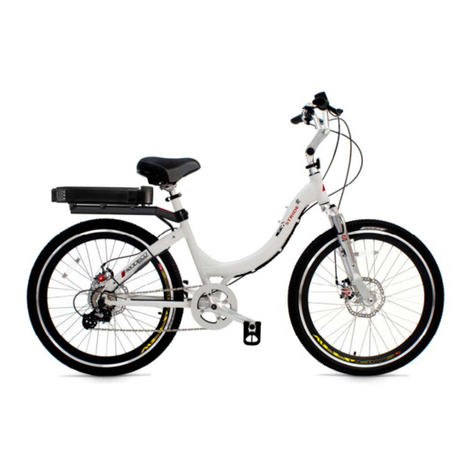
Prodeco Technologies
Prodeco Technologies G Stride R User manual

Prodeco Technologies
Prodeco Technologies G Storm User manual

Prodeco Technologies
Prodeco Technologies Mariner User manual

Prodeco Technologies
Prodeco Technologies Outlaw SS 2013 User manual

Prodeco Technologies
Prodeco Technologies G Plus Mariner 7 User manual

Prodeco Technologies
Prodeco Technologies Men's Fitness User manual
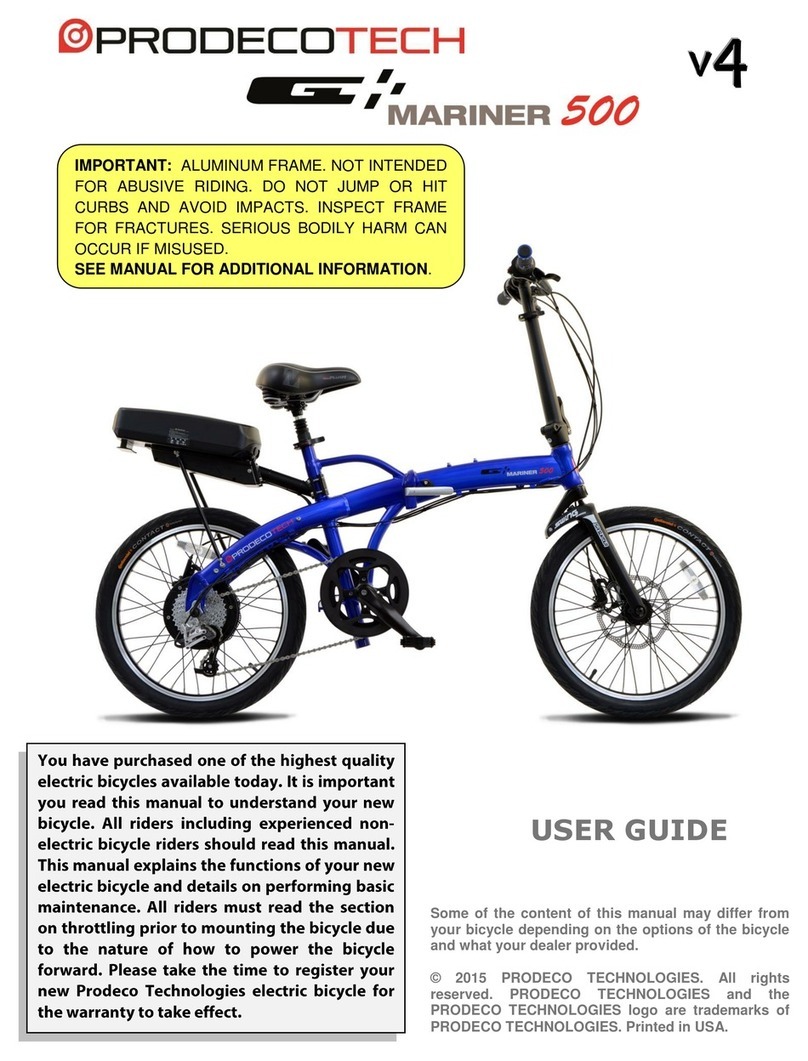
Prodeco Technologies
Prodeco Technologies Mariner 500 v4 User manual
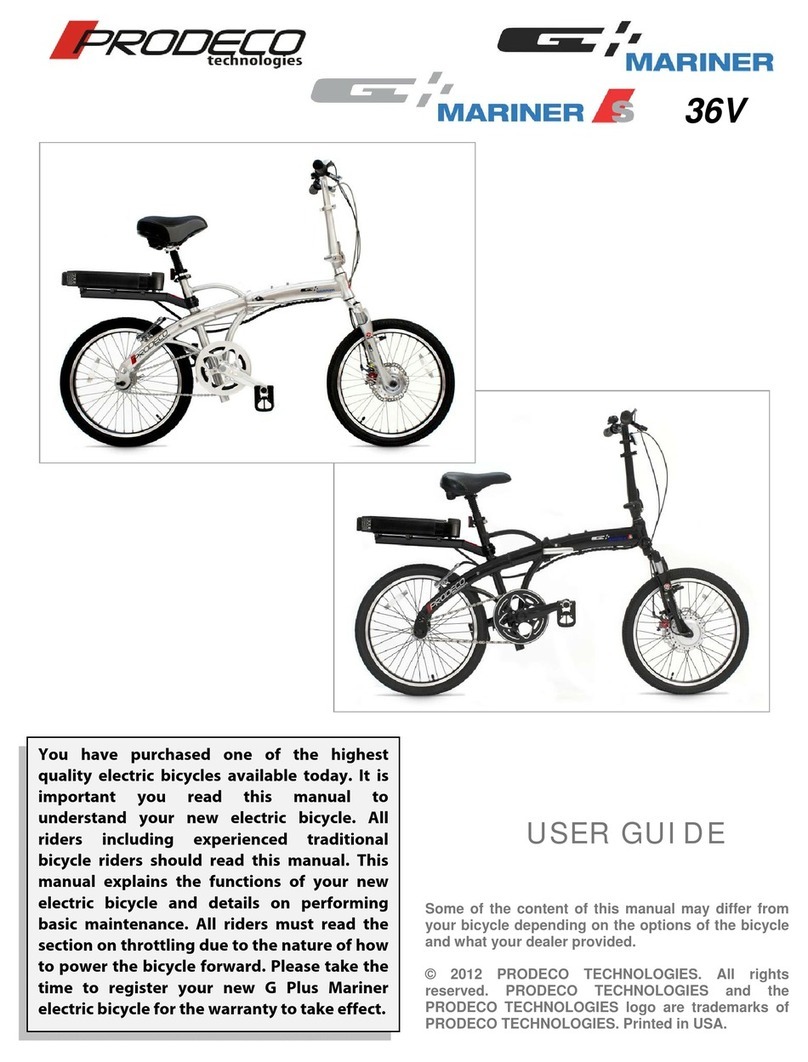
Prodeco Technologies
Prodeco Technologies G Plus Mariner 36V User manual

Prodeco Technologies
Prodeco Technologies Storm 2013 User manual
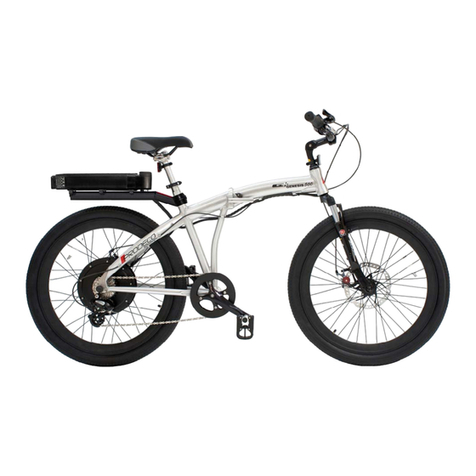
Prodeco Technologies
Prodeco Technologies Genesis 500 User manual
